Humpback Whales of Southeast Alaska Photo Tour
August, 2011
Trip Report
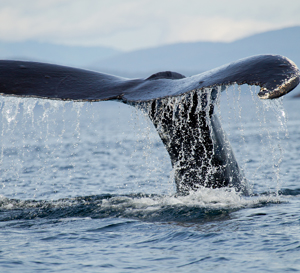
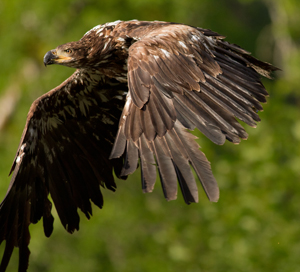
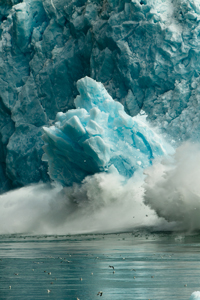
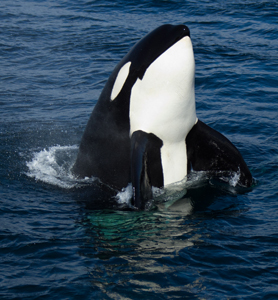
Read our Brochure for 2013
Read our 2009 Trip Report
You simply can't help yourself. You scream. You shout. You smile. Seeing a massive Humpback Whale rising unexpectedly like a silent Polaris Missle from a calm sea simply elicits a spontaneous exclamation of delight. There is nothing comparable in nature, except perhaps the prehistoric, nearly incomprehensible jumble of baleen, jaws, frothing water, and fleeing herring that rises from a ring of bubbles as a pod of Humpbacks surface when bubble-net feeding. This draws us to southeast Alaska regularly, to photograph truly one of Nature's greatest spectacles. This year, like our past trips to the island-studded channels of Alaska's Inside Passage, we were not disappointed.
The following is the day by day journal of the tour. Although the tour's emphasis was upon photographing Humpback Whales, arguably the most spectacular of the whales with the diverse behaviors they exhibit, the diversity of subjects we photographed was surprising, and rewarding. From calving glaciers to killer whales feeding upon a seal, HDR temperate rain forest landscapes to haunting sunset tableaus of whale, mountain, and sky, the shooting and experiences were nearly non-stop.
Day 1, August 1, 2011. Petersburg.
Low, overhanging clouds shroud the ridges surrounding Petersburg where we wait to board our boat, the Northern Song, for a one-week whale trip. The air feels damp and chill, and for most of us about thirty degrees cooler than what we’ve left at home. The tide is out, and the waterline now lies about fifteen or twenty feet below the high tide mark, and the now exposed flats are sprinkled with scattered gulls and fish crows. Earlier, while we were walking along the pier an unnoticed, distant Bald Eagle swooped down amidst the Common Ravens foraging along the brown and jumbled tide line and snatched a flounder, then flew directly towards us like a white bullet to pass within a frame-filling 70-200mm distance, had I had a lens. Common Ravens forage along the main street, picking at suspicious-looking slick food piles, vomit, I think, from a too busy Saturday night for someone. While our motel room fronted the main street, by 10PM last night the road was essentially empty, while now, twelve hours later, the street is busy with truck and car traffic, all of which stops for any pedestrian about to cross a street. At least that’s what a local told me as I started to cross and paused as a pickup truck neared. ‘Yeah,’ I said, ‘for a local. Me, I probably have a target on my back!’ She crossed with me as the pickup slowed to a stop.
We arrived in Petersburg yesterday via Anchorage, where we had overnighted after an 8 hour non-stop from Philadelphia. Not atypically, our hotel in Anchorage was inefficient, with one of our party being officially checked out a day earlier, although he still had his room. When we asked about getting a good breakfast the following morning the hotel staff told us of a restaurant down the street a quarter mile, neglecting to inform us that the hotel offered a very adequate breakfast as well. Each year, regardless of the hotel we’ve used, we’ve experienced ineptness in dealing with the Anchorage staffs, so it was a pleasure to return to the small hotel in Petersburg where things run on a more efficient, and expected, schedule.
Petersburg is a tiny fishing town of less than 3,000, fortunately supporting one Dentist whom two of our participants visited this morning, one with a potential abscess and another with a popped crown. This mountain-locked town features a great little bookstore offering a wonderful collection of local books, a noisy Mexican restaurant/bar, and a small waterfront restaurant, both filled the evening previous as we meandered through town looking for some place to eat. We settled at La Fonda’s, the Mexican place, after purloining spare chairs and tables from all four corners of the noisy bar to make our table of eight. One burly, pig-tailed local recommended a local tap beer, 'Arrogant Bastard,' which I mistakenly ordered as ‘Alaskan Bastard,’ and jerked my thumb at the guy beside me. He didn't take offense. The guy to my other side nodded approval at my wimpy Coors Light, and soon after, in a brief bar-side conversation told me of the big female Gray Wolf he’d seen earlier that day. He was a Forest Service employee, now getting ready for his date. The atmosphere was friendly, crowded and loud, and filled with locals, dressed pragmatically in weathered outdoor clothes. Over the next 2 hours are meals were served, one at a time, so that the first to be served were ready to leave for the hotel while the fifth to order was still waiting for a meal.
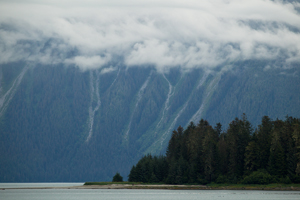 Our flight in yesterday offered a few tantalizing glimpses of the landscape, as the mountains rose high enough, or the clouds dropped low enough, to reveal long black ridges, occasionally scalloped broadly, with many of these U-shaped gullies appearing to be the start of the long glacial rivers. From this vantage, high overhead, I could fathom how a glacier might start as it appeared as if built up snow simply slipped off the ridges, caking and coalescing until they formed sufficient mass, I presume, to slowly start a downward flow. Sadly, many of the smaller, feeder glaciers seemed to end prematurely, not reaching the main branch or trunk which led deeper into the valley and, for many, ending at the sea.
Our flight in yesterday offered a few tantalizing glimpses of the landscape, as the mountains rose high enough, or the clouds dropped low enough, to reveal long black ridges, occasionally scalloped broadly, with many of these U-shaped gullies appearing to be the start of the long glacial rivers. From this vantage, high overhead, I could fathom how a glacier might start as it appeared as if built up snow simply slipped off the ridges, caking and coalescing until they formed sufficient mass, I presume, to slowly start a downward flow. Sadly, many of the smaller, feeder glaciers seemed to end prematurely, not reaching the main branch or trunk which led deeper into the valley and, for many, ending at the sea.
Flying in to Juneau we dropped into these clouds, IFR territory, until we dropped drop below the clouds, and low enough to pass surprisingly close to the nearest ridges. Only flying into mountainous Bhutan, in the foothills of the Himalayas, has offered a more exacting flight path. As we neared Petersburg our route skirted steep, forested slopes that appeared to rise directly from the sea, promising spectacular views should, or when, the weather clears.
PM. Our captain’s boat from our previous trip had run aground, sinking, and requiring the acquisition of a new boat, the Northern Song. It is, by any definition, spectacular, 60 feet long, 28 wide, with an enormous ‘living room’ and spacious dining area, and plenty of surface area for viewing whales. We motored out of Petersburg shortly after 2PM, after a brief but thorough safety lecture where we were introduced to the marshmallow-creating survival suits we’d wear if forced to abandon ship. In these arctic waters we’d last only minutes outside the suit, but with these thick neoprene coats one would last for hours.
Shortly after leaving our anchorage we encountered our first Steller’s Sea lions, hauled out on the channel markers which we circled several times. These endangered sea lions were unconcerned, and several leapt onto the buoys while we floated nearby. Later, as we backed close to a small iceberg to gather millennium-old glacial ice, we encountered our first Black-legged Kittiwake, whose field marks included the trademark legs and wingtips likened to being dipped in ink.
We passed a Bald Eagle perched upon an iceberg that permitted a fairly close approach, then, save for some scenery, the route was uneventful as we began motoring towards whale country. Just minutes before our scheduled 7PM dinner we spotted blows, three humpbacks in the distance. Our captain motored closer while we were called to dinner, and although the whales beckoned we were asked to honor the chef’s schedule as best we could and we complied. While we ate Jerome noticed a bubble net forming right beside our window and as we glanced out two whales blasted to the surface, within mere yards of our boat and in full view. While we obviously missed the shot the introduction was exciting as this was the first bubble net feeding the boat had seen. We finished diner quickly, asking our chef to hold off on dessert while we chased whales.
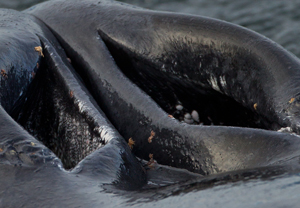 Over the next two hours under a lowering sky the three humpbacks, Stumpy, marked by a missing right tail fluke, another adult, and a juvenile or baby, performed wonderfully, undertaking multiple bubble net feedings, some quite close to the boat. It was a great introduction, giving everyone a sense of timing and speed that a bubble net feeding exhibits while providing some reasonably decent shots – great shots had the light been brighter. The last sequence of the day was perhaps the best as the juvenile, who breached cleanly out of the water once and did several spy-hops afterwards, joined a bubble net unexpectedly. Its presence, suddenly cresting the surface, surprised us and fooled some in to stopping the shooting as it appeared to be an example of lunge feeding and not the dramatic bubble net. I stayed on the ring of bubbles and a moment later the two adult whales surfaced while I continued to fire.
Over the next two hours under a lowering sky the three humpbacks, Stumpy, marked by a missing right tail fluke, another adult, and a juvenile or baby, performed wonderfully, undertaking multiple bubble net feedings, some quite close to the boat. It was a great introduction, giving everyone a sense of timing and speed that a bubble net feeding exhibits while providing some reasonably decent shots – great shots had the light been brighter. The last sequence of the day was perhaps the best as the juvenile, who breached cleanly out of the water once and did several spy-hops afterwards, joined a bubble net unexpectedly. Its presence, suddenly cresting the surface, surprised us and fooled some in to stopping the shooting as it appeared to be an example of lunge feeding and not the dramatic bubble net. I stayed on the ring of bubbles and a moment later the two adult whales surfaced while I continued to fire.
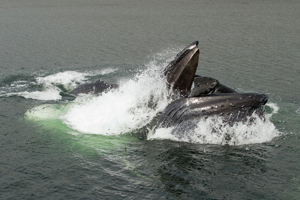 One whale faced me, its thin, almost blade-like upper jaw jutting straight up from the water. Fractions of a second later the lower jaw created an increasing plateau of water as its huge, wide lower jaw rose closer and closer to the surface. The lower jaw broke the surface in a froth of white, rising higher and higher until the jaws began to close and the whale settled back beneath the sea. All this at 10 frames per second, in a sequence that lasted less than 10 frames in all.
One whale faced me, its thin, almost blade-like upper jaw jutting straight up from the water. Fractions of a second later the lower jaw created an increasing plateau of water as its huge, wide lower jaw rose closer and closer to the surface. The lower jaw broke the surface in a froth of white, rising higher and higher until the jaws began to close and the whale settled back beneath the sea. All this at 10 frames per second, in a sequence that lasted less than 10 frames in all.
The light was failing and the whales moved off, and although they did one more lunge-feeding effort the show was over and everyone returned to the boat’s interior, happy and motivated by our luck and the incredible show they’d witnessed. It was a great start and introduction to the whales and one couldn’t have expected a better start than this.
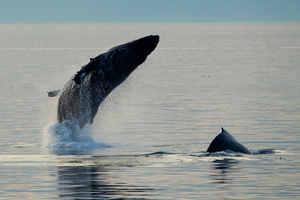
Day 2.
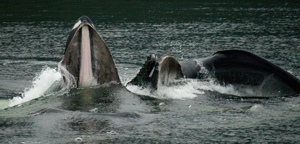 We overnighted close to our humpbacks and under a very heavy fog we spent the majority of the morning following Stumpy and the female and calf. Towards late morning the weather cleared temporarily and we had two close and excellent bubble-net feeding opportunities. I’d gone down to a lower deck for something when I heard Dennis, our captain, call out that there were bubbles. I hurried up the two flights of stairs/ladders to reach my cameras on the top deck, and forgot to duck inward for the narrow passage for the upper ladder and promptly cracked my head. Dennis thought a whale had bumped the boat – it was only my head, and as I recovered the whales surfaced, bubble-netting right next to the boat. I missed it, but Mary got it good. The fog rolled back in and, having spent several hours with the whales, we headed out and, as seems an ironic truism, just as we sat down for lunch we came upon distant Orcas, or Killer Whales. We ate quickly.
We overnighted close to our humpbacks and under a very heavy fog we spent the majority of the morning following Stumpy and the female and calf. Towards late morning the weather cleared temporarily and we had two close and excellent bubble-net feeding opportunities. I’d gone down to a lower deck for something when I heard Dennis, our captain, call out that there were bubbles. I hurried up the two flights of stairs/ladders to reach my cameras on the top deck, and forgot to duck inward for the narrow passage for the upper ladder and promptly cracked my head. Dennis thought a whale had bumped the boat – it was only my head, and as I recovered the whales surfaced, bubble-netting right next to the boat. I missed it, but Mary got it good. The fog rolled back in and, having spent several hours with the whales, we headed out and, as seems an ironic truism, just as we sat down for lunch we came upon distant Orcas, or Killer Whales. We ate quickly.
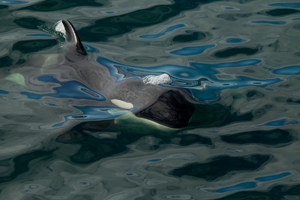 For the next four hours under essentially sunny and clear skies we had what was, according to our Captain, the best Orca experience he’s ever had. In all we probably had over 20 whales come through, some passing by, others circling us, and for nearly an hour a courting couple and several others that simply lulled about the front of our boat, mating occasionally, swimming close to the surface upside down, and lob-tailing periodically. I had my tripod on the lowest deck where earlier I’d tried to shoot near water-level shots and went down to retrieve it, and as I neared the upper deck and my camera everyone started screaming, as the male Orca had unexpectedly breeched completely out of the water. Most people saw it, but the breech was
For the next four hours under essentially sunny and clear skies we had what was, according to our Captain, the best Orca experience he’s ever had. In all we probably had over 20 whales come through, some passing by, others circling us, and for nearly an hour a courting couple and several others that simply lulled about the front of our boat, mating occasionally, swimming close to the surface upside down, and lob-tailing periodically. I had my tripod on the lowest deck where earlier I’d tried to shoot near water-level shots and went down to retrieve it, and as I neared the upper deck and my camera everyone started screaming, as the male Orca had unexpectedly breeched completely out of the water. Most people saw it, but the breech was 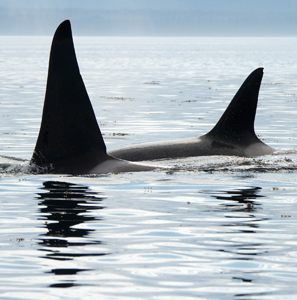 so fast that no one was ready and no one made the shot. Still, for those who saw it the breech was stunning, and had occurred only two or three whale lengths from the front of the boat.
so fast that no one was ready and no one made the shot. Still, for those who saw it the breech was stunning, and had occurred only two or three whale lengths from the front of the boat.
I’d started with two fresh 16gb cards after lunch and filled both with two cameras, and started 2 fresh cards again, and at almost 700 images per card I suspect our group shot over 10,000 whale images today, if not on the Orcas alone. While it was probably only coincidence, the Orcas certainly appeared to have sought us out and stayed with us, feeding off our shouts of glee and appreciation as they swam about the boat. Who knows?
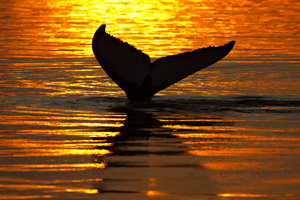
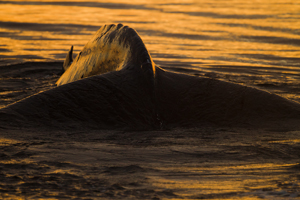
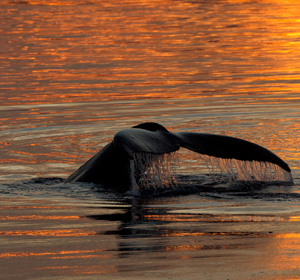
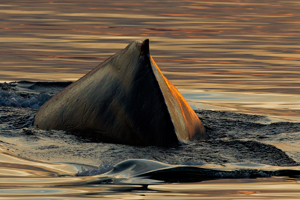
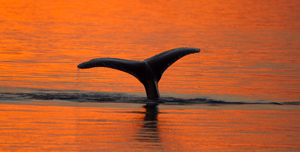 We left the orcas and began cruising towards our next destination, a good humpback concentration, and we arrived, of course, right as diner was served. Our plan was to film the humpbacks sounding and fluking against the late afternoon light and sunset skies, so our meal wasn’t especially hurried. We ate and headed into the sun, lining up the boat to silhouette birds against the late light. The whales cooperated wonderfully and we had multiple opportunities to frame soundings and whale tails against a streak of sunset orange, water dripping liquid gold from the trailing edge of the broad flukes. We shot until almost 9PM, as the sunset light simply broadened across the sky and whales cruised about, some lunge-feeding and eating krill which they apparently rounded up by bubble-net blowing down deep, gathering the krill into a ball that can be swept up in their giant jaws.
We left the orcas and began cruising towards our next destination, a good humpback concentration, and we arrived, of course, right as diner was served. Our plan was to film the humpbacks sounding and fluking against the late afternoon light and sunset skies, so our meal wasn’t especially hurried. We ate and headed into the sun, lining up the boat to silhouette birds against the late light. The whales cooperated wonderfully and we had multiple opportunities to frame soundings and whale tails against a streak of sunset orange, water dripping liquid gold from the trailing edge of the broad flukes. We shot until almost 9PM, as the sunset light simply broadened across the sky and whales cruised about, some lunge-feeding and eating krill which they apparently rounded up by bubble-net blowing down deep, gathering the krill into a ball that can be swept up in their giant jaws.
Day 3.
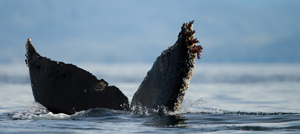 We anchored overnight nearby and the next morning headed out into the straits where we once again encountered the humpbacks. Dark log-like shapes marked lulling or sleeping whales while in the distant periodically a tiny black shape would appear momentarily and quickly subside, breaching humpbacks that briefly rose into view. Dennis and Leanna unloaded the large zodiac for some water-level shots of the closer whales and Mary, Tom, Fonda, and Joyce took the first shift. They motored slowly and quietly to the nearest whales, which nearly surrounded them as the whales slowed swam passed. Through the course of their skiff ride that group did exceptionally well, shooting whales quite close as they swam by unconcerned and, among the last shots of their ride, catching a brilliant white tail of a whale sounding, framed by the distant snowy mountains.
We anchored overnight nearby and the next morning headed out into the straits where we once again encountered the humpbacks. Dark log-like shapes marked lulling or sleeping whales while in the distant periodically a tiny black shape would appear momentarily and quickly subside, breaching humpbacks that briefly rose into view. Dennis and Leanna unloaded the large zodiac for some water-level shots of the closer whales and Mary, Tom, Fonda, and Joyce took the first shift. They motored slowly and quietly to the nearest whales, which nearly surrounded them as the whales slowed swam passed. Through the course of their skiff ride that group did exceptionally well, shooting whales quite close as they swam by unconcerned and, among the last shots of their ride, catching a brilliant white tail of a whale sounding, framed by the distant snowy mountains.
Bill, Rich, Jerome, and I did the next shift, but by then the whales had scattered and although we had a few swim by none came close, and the few tail flukes and soundings we had were fairly distant and disappointing. A fog was rolling in from the southwest, obscuring Five Fingers Lighthouse and began to shroud our boat, and, not wishing to risk losing our boat in a thickening fog, we headed in.
We headed towards Admiralty Island, one of the largest islands in the southeast straits, and home to coastal Brown Bears and some great salmon rivers. En route, just an hour ahead of us as we left the whales, lay a small forested island where Steller Sea Lions haul out to bask. Distances, or forward progress, can be deceiving, and the island appeared to be only a few minutes ahead but it was truly an hour later as we drifted in towards the Sea Lions, who lined the rocky beach in numbers and, far above tide line, lay in piles like drifted timber on a broad flat expanse.
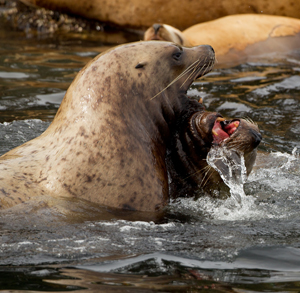
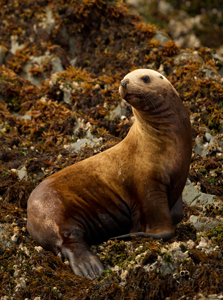
Steller’s Sea Lions are endangered, although here in the southeast their numbers are holding steady. Elsewhere and in many parts of coastal Alaska their numbers have dropped considerably, and the cause of this is unclear, as it might be from over-fishing of the salmon or heavy predation by orcas. Either way, this once abundant sea mammal is now considerably reduced.
Sea Lions get their name from their vague resemblance, in the male, of an African lion, as both seemingly have thick, maned necks. In lions, however, this thickness is from the thick coat of hair, a true mane, that covers the neck and upper shoulders. Beneath that hair the proportions of a male and a female lion are essentially the same. While the male Sea Lion’s neck is more thickly furred, there is a sexual dimorphic difference in body shape as well, with males being two or three times larger than a female, and with a much thicker, more muscled neck.
There is some real confusion in nomenclature among the seals, or Pinnipeds. Seal Lions are ‘seals,’ but there are true seals and there are ‘eared’ seals. The whole group were once grouped in their own taxonomic order, the Pinnipedia, Latin for wing or fin-footed, with three subgroups, but all have been grouped more appropriately in the taxonomic order Carnivora, with three Families of ‘seals’ in this subdivision, just as there are other Families that comprise the weasels, the cats, the dogs, the bears, and other meat-eating fanged mammals. As seals, however, the confusion lies in the difference between Sea Lions and seals and which one is which. To be precise, the differences lie in whether or not the Pinniped has ears. The True Seals, like the Harbor Seals we saw in Petersburg harbor, lack external ears. Their hind limbs or flippers cannot rotate forward but instead are permanently facing backwards. On land, these true seals, or earless seals, hump forward in a caterpillar-like motion, pulling themselves forward with their front flippers. In water, these hind flippers serve to propel the seal, just as does the tail of a dolphin or porpoise.
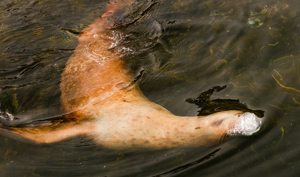
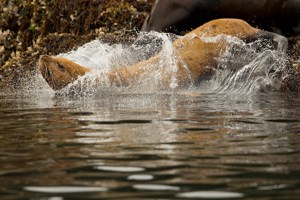
Eared seals, like the Steller’s Sea Lion, have external ear flaps and hind flippers that can rotate forward, allowing them to move almost as if they have legs, and the eared seals can move quickly, galloping across a beach to chase intruders or unwary tourists. The confusion here is that some ‘eared’ seals are called ‘sea lions’ while others in this Family are referred to as ‘seals.’ For example, the eared seal of the Galapagos is referred to as the Galapagos Fur Seal, and in Antarctica one might see two similar looking species, the Antarctic Fur Seal and the South American Sea Lion. Both are eared, and both have hind flippers that rotate. If any conclusion can be drawn, those eared seals termed ‘sea lions’ are usually larger, with the male having huge, bulky necks. The eared seals called ‘seals’ have big necks as well, just not so big! Of course, the Australian Fur Seal and the Australian Sea Lion both have huge necks … so you figure it out.
At any rate, we spent nearly two hours with these eared seals as they play-fought in the surf, scrambled around on the rocks, or posed in the typical ‘eared seal’ pose, head upright, pointing skyward. Surfbirds, nondescript and cryptic black mottled shorebirds foraged unnoticed amongst the barnacles and stranded kelp often within feet of the larger, more conspicuous Black Oystercatchers that perched on the rocks nearby. Lunch neared, and for once we were finished photographing before a meal even started, and we backed off from our viewing area and moved on.
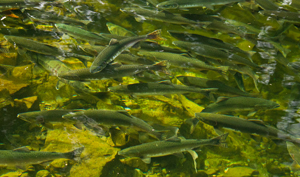 In the afternoon we headed towards Admiralty Island and Gambier Bay to a small stream choked with silver salmon. Dennis took our zodiac skiff upstream and, as it was high tide, we traveled almost to the forest edge. Salmon darted beneath our skiff in thick waves, and upstream, in the shallows, the water periodically boiled as fish panicked and raced to a different section of the stream. We found a dry spot to land, where Tom, in looking for a good path, sunk to knee-level in a hidden channel, filling his boot with cold water. We found a different path and entered the forest, entering a chamber that glowed green, with thick moss underfoot and lichens, moss, and ferns draping old limbs and the massive tree trunks of this spruce forest. Bear droppings were everywhere, huge piles of chewed, black grass, berries, or oily piles of fish. The undergrowth was rooted and torn in many places from the bear activity, and we spoke loudly as we walked, giving any bear fair warning that we were entering their land. Fortunately, we didn’t see a bear.
In the afternoon we headed towards Admiralty Island and Gambier Bay to a small stream choked with silver salmon. Dennis took our zodiac skiff upstream and, as it was high tide, we traveled almost to the forest edge. Salmon darted beneath our skiff in thick waves, and upstream, in the shallows, the water periodically boiled as fish panicked and raced to a different section of the stream. We found a dry spot to land, where Tom, in looking for a good path, sunk to knee-level in a hidden channel, filling his boot with cold water. We found a different path and entered the forest, entering a chamber that glowed green, with thick moss underfoot and lichens, moss, and ferns draping old limbs and the massive tree trunks of this spruce forest. Bear droppings were everywhere, huge piles of chewed, black grass, berries, or oily piles of fish. The undergrowth was rooted and torn in many places from the bear activity, and we spoke loudly as we walked, giving any bear fair warning that we were entering their land. Fortunately, we didn’t see a bear.
We headed upstream to the shallows where the salmon had congregated in a downstream deeper pool, perhaps waiting for their eggs to ripen further before starting their last push across the punishing shallows of sharp rocks, bear jaws, and eagle talons. The photography was tough, and we looked for shady areas where sky reflections were minimized and our polarizers could do the most good. I used flash off camera and directed into the water, lighting up the salmon and freezing their motion, and a wide-angle to incorporate a portion of the forest and shoreline in scene. We were watching our time, for if the tide dropped we’d have a mile walk across the mudflats and rocks to catch the zodiac, and, since the zodiac was with us, we were careful too not to get marooned. We exited without incident.
Day Four.
A front that promised rain delivered, and the morning was dreary, wet, and foggy. Some Dall Porpoises joined our boat for a few minutes, but by the time we suited up these small, orca-colored porpoises had lost interest and gone off. We spent the morning editing.
We headed across Chatham Strait, encountering some gentle ocean swells that were sufficient to tip one of our party into seasickness (not too severe) as we motored towards Baranoff Island.
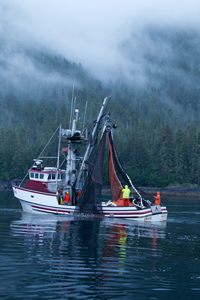
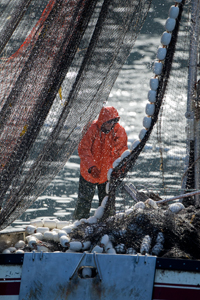
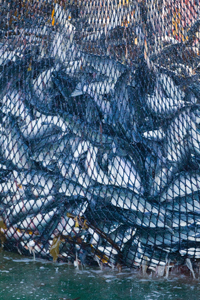
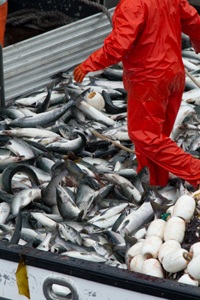
Along the way we moved up on a salmon purse seining boat in the process of hauling up their net, filled with a ton or more of pink salmon. As the net rose from the water a pink goop filtered through the net, jellyfish crushed by the weight of the salmon and now oozing as a gelatinous mess through the netting. On deck, as the orange-suited fishermen shuffled and kicked the fish into the holding tanks the salmon thrashed about, making for an interesting but somewhat depressing image, at least if you could vaguely empathize with a fish.
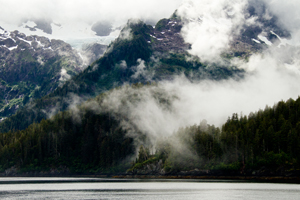 As we neared Baranoff the western sky began to clear, first as a tiny pocket of blue high above the mountain ranges, with fog ebbing and flowing over lower ridges, providing a continuous and ever-changing show. There is something about fog and ridges and dark tree silhouettes, as the shapes lend themselves to challenging graphics that Joyce and I worked on, as the rest of the crew worked on editing or sleep.
As we neared Baranoff the western sky began to clear, first as a tiny pocket of blue high above the mountain ranges, with fog ebbing and flowing over lower ridges, providing a continuous and ever-changing show. There is something about fog and ridges and dark tree silhouettes, as the shapes lend themselves to challenging graphics that Joyce and I worked on, as the rest of the crew worked on editing or sleep.
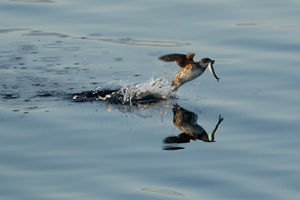 We headed up a narrow fjord, one of the tall, steep glacial carved channels that dissect the Alaskan coast. Marbled Murrelets dipped before us in the dark waters and Bonapart’s and Mew Gulls paddled safely to our side as we motored by. The Marbled Murrelet’s nest was the Holy Grail of nesting birds, as the location of their nesting was undiscovered until the mid-1970’s, when it was found the birds nest on mossy tree limbs high in the conifers of the coastal temperate rain forest. Other Murrelets nest on ledges or in the alpine tundra and the Marbled is exceptional in nesting in trees. This, as small and seemingly insignificant as this seabird may be, has been another data point in the preservation of these forests.
We headed up a narrow fjord, one of the tall, steep glacial carved channels that dissect the Alaskan coast. Marbled Murrelets dipped before us in the dark waters and Bonapart’s and Mew Gulls paddled safely to our side as we motored by. The Marbled Murrelet’s nest was the Holy Grail of nesting birds, as the location of their nesting was undiscovered until the mid-1970’s, when it was found the birds nest on mossy tree limbs high in the conifers of the coastal temperate rain forest. Other Murrelets nest on ledges or in the alpine tundra and the Marbled is exceptional in nesting in trees. This, as small and seemingly insignificant as this seabird may be, has been another data point in the preservation of these forests.
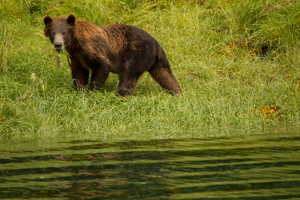 These fjords shelter bears, and we soon closed on a young male Brown Bear that was foraging along the shoreline, grabbing mouthfuls of beach grass as it moved along quite unconcernedly. Sadly, as tame and seemingly oblivious as this bird was, bear hunting is allowed here and from boats, provided there is no forward motion of the boat while actively hunting. Who is there to enforce that rule is another matter, but regardless, from the behavior of this bear and others we subsequently observed, bagging a bear on the shoreline of the fjords seemed quite unfair and unsporting.
These fjords shelter bears, and we soon closed on a young male Brown Bear that was foraging along the shoreline, grabbing mouthfuls of beach grass as it moved along quite unconcernedly. Sadly, as tame and seemingly oblivious as this bird was, bear hunting is allowed here and from boats, provided there is no forward motion of the boat while actively hunting. Who is there to enforce that rule is another matter, but regardless, from the behavior of this bear and others we subsequently observed, bagging a bear on the shoreline of the fjords seemed quite unfair and unsporting.
We dropped anchor at the headwaters of the fjord, a few hundred yards from the mouth of a small salmon stream. Most of the photographers went out on several skiff rides while Mary and I took a two-man kayak and paddled along the shoreline, eventually going a short distance up the salmon stream. We’d barely started when we found a bear working along the shoreline, but the bear had moved into thicker cover by the time we paddled close. The low perspective of the kayak, however, was wonderful for the Red-breasted Mergansers and Mew Gulls we 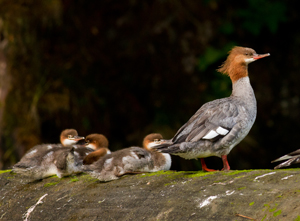 photographed. I was using a 400mm F5.6 now IS lens on a Canon 7D, giving me the equivalent focal length of a 640, and the lack of image stabilization was telling. My image, at this rather high magnification, was jumping everywhere, and my only hope was to fire motor-drive bursts where one image might be acceptably sharp.
photographed. I was using a 400mm F5.6 now IS lens on a Canon 7D, giving me the equivalent focal length of a 640, and the lack of image stabilization was telling. My image, at this rather high magnification, was jumping everywhere, and my only hope was to fire motor-drive bursts where one image might be acceptably sharp.
This image jumpiness was especially prevalent as we moved in on an immature Bald Eagle that allowed a close approach. The bird perched on a series of fallen tree trunks at close to frame-filling range, and now, in retrospect, I think I’d have been better with my light weight 70-200 f4 lens with IS, and later cropping. Chances are I’d have sharper images as a result.
We had our bear again, once as it swam across a small bay rather than skirt the shore, and later, as we paddled up the salmon stream it crossed in front of us twice. I stepped ashore and the bear reappeared, but moved off before I had a chance at another photo. The current was fast enough that paddling further upstream was too difficult but with the incredible numbers of salmon we passed over and by, it’d have been interesting to see the shallow waters where they spawned.
We paddled back as chill clouds started gathering over the western ridges, dropping the light as we returned to the boat. Periodically, salmon leapt for flies or jubilance, and we tried catching a fish mid-air, and did so unsuccessfully. Last night we dropped three shrimp traps, and captured well over a hundred shrimp, and tonight’s dinner was our first of fresh shrimp. We over-ate.
Day Five.
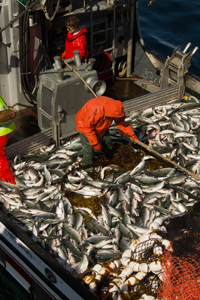
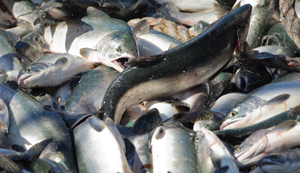
At breakfast, from our anchorage at Baranof we watched a Brown Bear swimming across the bay. The skies were clear, and the front was passed as we backtracked down the fjord and crossed the Chatham Strait. Dennis arranged for us to meet up with another salmon sein netting operation, and we were able to watch the entire process. An outboard drags the net out from the main boat, inscribing a large half circle. After a few minutes the outboard motors back to the main boat, drawing the lower line which begins to cinch up the bottom of the net, creating the bowl. From our vantage on the top deck of the Northern Song we had a nice 3-D view as the outboard finished the cinching and the main boat started winching up the net. Another good catch with hundreds of salmon, and our boat slid in close giving us an almost aerial view of the salmon catch on deck. All this occurred at Kuiu Island.
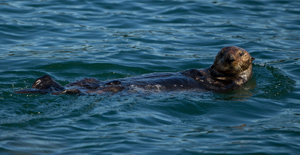
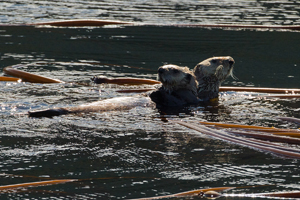
Heading north we moved into Sea Otter territory and soon encountered several huge rafts of dozens of otters. Sea Otters are the most aquatic, or marine member of the mustelid (or weasel family, and are noted for having perhaps the richest, densest fur in the animal kingdom, which almost accounted for the extinction. The otters have enjoyed some sort of a comeback with protection, but depredation by orcas has reduced some Alaskan populations.
Most of our otters were shy, but as we slowly motored about we bumped into several that were fairly tolerant, giving us near frame-filling shots of otters floating on their backs. These marine mammals may never touch land, as females will give birth and nurse at sea, generally in the 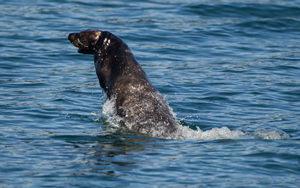 safety of the kelp beds. We spotted a few females with large young that clung or rode upon their mothers’ bellies, and as a female dove she would dislodge the pup and move it to her side. Our last otters were a pair that porpoised ahead of us, periodically ducking beneath the sea, then popping up in a low arching leap.
safety of the kelp beds. We spotted a few females with large young that clung or rode upon their mothers’ bellies, and as a female dove she would dislodge the pup and move it to her side. Our last otters were a pair that porpoised ahead of us, periodically ducking beneath the sea, then popping up in a low arching leap.
After lunch we headed towards the tiny fishing village of Kake, where we planned to visit the salmon fishery and creek where black bears and bald eagles frequent. We hadn’t traveled far when Dennis, our captain, casually mentioned that we had some ‘big sails’ ahead, more Orcas. All of us raced on to the deck where three or four Orcas were milling about, with one breaching as we approached.
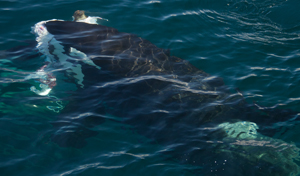 The Orcas were feeding upon halibut, and put on quite a show. The lucky whale would bob up and down in a humping motion as it tore the fish apart, often drawing the other whales in where they would attempt to steal pieces. At times we had six Orcas swimming about, often quite close to the boat, and always returning to the boat to either play or to tear apart another fish.
The Orcas were feeding upon halibut, and put on quite a show. The lucky whale would bob up and down in a humping motion as it tore the fish apart, often drawing the other whales in where they would attempt to steal pieces. At times we had six Orcas swimming about, often quite close to the boat, and always returning to the boat to either play or to tear apart another fish.
As incredible as it may seem, the Orca show today was even better than our previous encounter, with the water calm enough that whales underwater were visible, allowing the use of polarizing filters. We had several spy-hops, with Orcas bobbing high, and once, when I was on the lower deck an 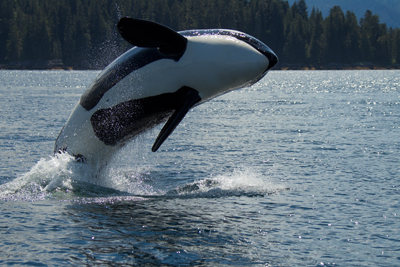 Orca breached near by. I had my 28-300 zoomed full out when the Orca broke the water’s surface and I fired four shots with only the pectoral fins and belly within the frame. I zoomed back by frame 5 and caught the orca fully within view, just after the whale had reached its peak and began its descent, smashing into the sea. Rich was on an upper deck as the whale breached and fired off-hand, with his eye away from the viewfinder, but caught the latter half of the breach within its frame.
Orca breached near by. I had my 28-300 zoomed full out when the Orca broke the water’s surface and I fired four shots with only the pectoral fins and belly within the frame. I zoomed back by frame 5 and caught the orca fully within view, just after the whale had reached its peak and began its descent, smashing into the sea. Rich was on an upper deck as the whale breached and fired off-hand, with his eye away from the viewfinder, but caught the latter half of the breach within its frame.
The whales stayed around our boat for over 2.5 hours or so, and several times they seemed to quit only to catch another halibut and start another feeding show. Finally the whales set off determinedly, and at their last dive resurfaced a half mile ahead, on a mission and we let them go.
Kake, a tiny, run-down fishing village, was a bit of a disappointment as the tide was in and although there were plenty of salmon only one Black Bear appeared, and that one showed up after most of us had left. Jerome and Fonda were waiting for a taxi and had stayed on when a small bear appeared, and Jerome got a few shots in the low light. I spent my time at the salmon sluice way where salmon fought up the narrow clefts to reach the breeding area. Using flash, I tried freezing a fish as it leaped, but I didn’t have much luck.
Day 6
We had planned to do another visit to the salmon hatchery for bears and eagles but aside from one person, and me, there wasn’t much enthusiasm to go so we headed out to look for humpbacks breaching. We encountered many whales but the morning involved a lot of tails, and we were seeking bigger game – the breaches.
Shortly after leaving Kake we did encounter a Black Bear on the beach which permitted OK animal in habitat shots, with the bear on the stone beach or against the fireweed. A Bald Eagle perched in a tree tempted us for flight shots, but the bird remained perched and we moved on.
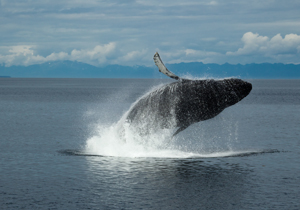 By early afternoon we were back at the Five Brothers Lighthouse where we had plenty of whales, and towards Sail Island, where we had our sea lions, a whale was flipper slapping and breaching. It took nearly 40 minutes to reach the whale which had since fallen asleep, lying like a log and periodically rising to take a blasting breath. Finally, it awoke and started moving off, breathing heavily and loudly, producing a roaring-like bellow, quite unlike its earlier breaths. The whale sounded, and stayed down long, and I had a feeling that it might breach. It did, close to the boat, but despite my suspicions I wasn’t quite ready and only caught the last half of the breach. Still, it was a good start.
By early afternoon we were back at the Five Brothers Lighthouse where we had plenty of whales, and towards Sail Island, where we had our sea lions, a whale was flipper slapping and breaching. It took nearly 40 minutes to reach the whale which had since fallen asleep, lying like a log and periodically rising to take a blasting breath. Finally, it awoke and started moving off, breathing heavily and loudly, producing a roaring-like bellow, quite unlike its earlier breaths. The whale sounded, and stayed down long, and I had a feeling that it might breach. It did, close to the boat, but despite my suspicions I wasn’t quite ready and only caught the last half of the breach. Still, it was a good start.
The whale breached several times after that, and for one I was on just as its nose cleared the surface and started rising, providing a fairly good sequence. Another, more distant one rose half off the frame as I tried shooting vertically, as its broad white pectoral fins fanned outward, and outside the frame. Throughout the rest of the afternoon we had a couple more chances with other whales, and saw plenty that were too far off, or stopped, by the time we reached them. At one point two breached simultaneously, but they were far and only one person caught the back end of the leap.
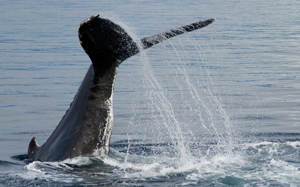 One of the breaching whales also performed by doing a tail-slapping display, smashing the water repeatedly, sometimes lying upside down to slap, sometimes doing so right side up. The whale also did multiple pectoral slaps which, from a distance, are sometimes confused with breaches as the long fins extend high into the air.
One of the breaching whales also performed by doing a tail-slapping display, smashing the water repeatedly, sometimes lying upside down to slap, sometimes doing so right side up. The whale also did multiple pectoral slaps which, from a distance, are sometimes confused with breaches as the long fins extend high into the air.
Dennis, our Captain, cooked dinner this evening, a wonderful King Salmon over alder planks on the barbeque, and it was stellar. Afterwards, in the last 1.5 hours of the day we stalked more humpbacks, attempting to catch them against the glowing western sky. Two different whales breached as well, but none were close, but our evening ended excitedly when a trio of whales rose close to the boat multiple times as they lunge-fed on krill. The light was really failing, but we shot at high ISOs and slower shutters anyway, until the light dropped too low for even over-enthusiastic photographers.
Day 7.
We anchored near the whales and hoped to catch more breaching but the whales had dispersed and although there were a few, very few, breaches in the distance there were not enough to justify staying in the area. We headed to Farragutt Bay where we hoped to encounter Stumpy the whale bubble-net feeding but the bay was empty. We headed on, which gave everyone time to start editing and sorting for our big slide show that evening.
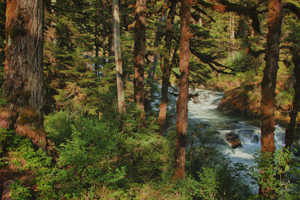
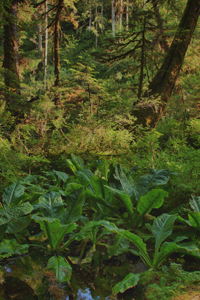
In late afternoon we stopped at Scenery Cove in Thomas Bay where we cruised in for fjord scenic, enjoying the steep, polished, scraped cliff sides, the product of the glaciers that helped carve the fjords and scraped to hard bedrock anything before them. A short while later we anchored by Cascade Creek where a Forest Service trail leads along the fast-moving stream to a water fall and then beyond to a lake 3 miles further on. We climbed the steep trail comprised of carved logs and planks, creating a very sound footing, ascending through verdant green temperate rain forest. From the water the forest looks dull and monotonous, with coniferous trees, mainly spruce, fir, hemlock, and cedar, masking the undergrowth below. Inside the forest it is almost shocking, green and rich, an understory of Western Skunk Cabbage in wet spots, various berries and low shrubs and ferns in the drier areas, and trees festooned with thick moss and goats beard lichens. Unfortunately it was sunny – I’d have loved to have hiked through here on a foggy, rainy day – so I did several HDRs which I converted with the new NIK HDR program, using their default settings for Landscape or Scenic and producing very nice results.
Leaving the anchorage we headed south, to our next and last destination, LeConte Glacier. After dinner I put together a slide show comprised of most of our participants work. It was an incredible show, and surprising images that made me wonder where the heck I was when that photo was taken! It was a great show and made us wish we could do it all again!
Day 8.
Our last day and a full one. At 7:30AM Rich, Tom, and Joyce took a float plain flight-seeing trip over LeConte Glacier and the Devil’s Thumb, a huge granite projection that is a landmark here, and a world-class mountaineering challenge. They loved it, and returned an hour or so later where we proceeded on into the LeConte channel to the Glacier.
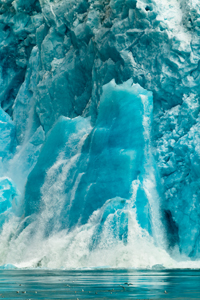 We circled several weathered and blue ice glaciers, doing close ups and landscape shots before continuing through the glacial-scraped fjord to the face of the glacier. This glacier moves about 90 feet a day, not progressing but instead calving constantly, and we hoped that as we watched and waited an iceberg or two would calve.
We circled several weathered and blue ice glaciers, doing close ups and landscape shots before continuing through the glacial-scraped fjord to the face of the glacier. This glacier moves about 90 feet a day, not progressing but instead calving constantly, and we hoped that as we watched and waited an iceberg or two would calve.
We were successful, with several making small cracks and cascades that eventually culminated in massive, skyscraper-sized towers and walls blasting into the frigid sea. In a motor drive sequence, and to the eye, the spectacle is indeed spectacular, but catching a defining shot that truly tells the story in a single image is far more challenging. A movie would do it, but a still … I used my 500mm and tried isolating detail, hoping that the vignette, showing only the dropping wall and splashing sea, would do the event justice.
On several occasions ‘shooters’ blasted up from the deep, where glacial ice breaks off underwater and shoots to the surface, often quite unexpectedly. I was downstairs, grabbing seconds on lunch when Dennis yelled that the boxcar, an ice formation we named that hung rather far from the glacial face, was going, and that the entire wall was going. I raced upstairs, too late to see the wall crash into the sea but in time to see the aftermath, as an enormous wall of ice rose back out of the sea, followed by more shooters that rocketed like breaching whales against the ice cliff. All of this ice creates an enormous bow wave, and this one was so large it actually formed a wave curl as it rolled forward. By the time it reached our boat the curl had vanished, but we rocked up and down rather violently from the successive swells. It was, quite possibly, the best calving sequence we’d ever seen.
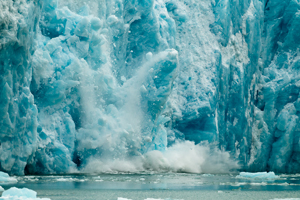 We had had our eyes on another likely spot, an ice cave that had formed as ice sheared off near water level, but the action seemed over and we headed out of the channel, hoping to beat an ice jam from the huge amounts of ice added in the last hour. Harbor Seals, which had been strangely missing as we motored in, were now hauled out on the ice floes by the hundreds. Normally, there are seals here, but most are skittish and disappear as our boat would near. Today we were lucky, and we drifted to within near-frame filling distance, certainly great ‘animal in habitat with detail’ range.
We had had our eyes on another likely spot, an ice cave that had formed as ice sheared off near water level, but the action seemed over and we headed out of the channel, hoping to beat an ice jam from the huge amounts of ice added in the last hour. Harbor Seals, which had been strangely missing as we motored in, were now hauled out on the ice floes by the hundreds. Normally, there are seals here, but most are skittish and disappear as our boat would near. Today we were lucky, and we drifted to within near-frame filling distance, certainly great ‘animal in habitat with detail’ range.
 Some seals rose and with their humping gait and front flippers lurched to the edge of an ice flow and slipped in, while others merely watched. These ‘true seals,’ that is those lacking external ears and having flipper-like immobile hind limbs, have strong gripping claws on their fore flippers which they use to grasp a hold of ice to move about, or to haul themselves out of the water. We watched several as they neared a floe, and we expected the seals to swim fast and dive out of the water. Instead, in the near choking pile of ice and slush they just pushed about with their heads until they reached an edge, then bobbed up, grabbed the ice, and pulled themselves aground.
Some seals rose and with their humping gait and front flippers lurched to the edge of an ice flow and slipped in, while others merely watched. These ‘true seals,’ that is those lacking external ears and having flipper-like immobile hind limbs, have strong gripping claws on their fore flippers which they use to grasp a hold of ice to move about, or to haul themselves out of the water. We watched several as they neared a floe, and we expected the seals to swim fast and dive out of the water. Instead, in the near choking pile of ice and slush they just pushed about with their heads until they reached an edge, then bobbed up, grabbed the ice, and pulled themselves aground.
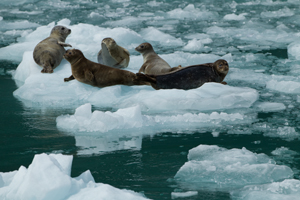
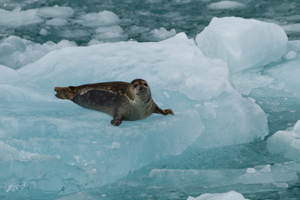
As I write this we’re still on the water, heading back to Petersburg where we’ll have a final group dinner and review the trip highlights, favorite shooting locations and subjects, and favorite shots. That recap is always fun, and after just doing a group slide show on the boat’s large screen TV, where we displayed over 270 images from the trip taken by all of the shooters, we’ll be primed and refreshed for the final dinner’s activity.
It is probably unexpected to find how tiring and exhausting this trip can be, considering that we only walked on land two or three times, and the only other physical activity was some kayaking for Mary and I. But being on one’s feet all day, watching for whales, and holding or switching cameras as one goes from a tripod-mounted big telephoto to a heavy hand-held zoom, is surprisingly taxing. As I write this in the spacious kitchen area (larger than our kitchen at home), three of our participants are sprawled out on the couches, fast asleep.
Afterword.
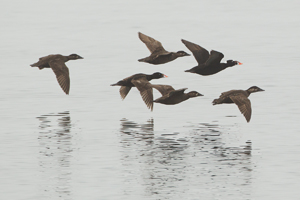 That evening we had our final dinner, delayed somewhat by Mary, Bill, and Rich doing laundry in preparation of the next two weeks on the bear boat. Fortunately our restaurant was nearly empty and they held our table, as it was nearly empty of entrees except for hamburgers, which we all craved.
That evening we had our final dinner, delayed somewhat by Mary, Bill, and Rich doing laundry in preparation of the next two weeks on the bear boat. Fortunately our restaurant was nearly empty and they held our table, as it was nearly empty of entrees except for hamburgers, which we all craved.
The highlights were diverse, with almost every aspect of the trip a highlight for one person or another. Some had the humpbacks, either seeing and photographing a breach or the incredible bubble-net feeding behavior. Or the Orcas, and all of the activity we had with these killer whales. Or the LeConte Glacier and the exciting calving. For me, despite all the wonderful mammal activity it was the quiet kayak ride Mary and I took, where we filmed bears, eagles, mergansers, and gulls from water level. The photo highlights, and we asked for three, was diverse as well, with bubble net feeding and breaching, orcas breeching or eating the seal, sea otters, landscapes and glaciers, and the Steller’s sea lions. As we reviewed the trip it was surprising how all of us forgot some of the special moments each of us had, for there truly were too many.
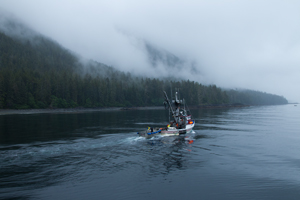 We flew out from Petersburg the next morning, and I found that my initial comments, or thoughts, about this small fishing town had changed. As I raced about the downtown main street looking for a fast breakfast and rain pants for Mary I found nearly everyone saying hello or hi or excuse me or nodding, with the shop owners and staff friendly and helpful and fun. I could see how someone could fall into living here easily, despite its remoteness, and it was a great feeling to have in leaving this place as we plan to return again in two years for another exciting whale tour, one that we found offered so much more than simply whales.
We flew out from Petersburg the next morning, and I found that my initial comments, or thoughts, about this small fishing town had changed. As I raced about the downtown main street looking for a fast breakfast and rain pants for Mary I found nearly everyone saying hello or hi or excuse me or nodding, with the shop owners and staff friendly and helpful and fun. I could see how someone could fall into living here easily, despite its remoteness, and it was a great feeling to have in leaving this place as we plan to return again in two years for another exciting whale tour, one that we found offered so much more than simply whales.

Humpback Whales of Southeast Alaska Photo Tour
August, 2011
Trip Report




Read our Brochure for 2013
Read our 2009 Trip Report
You simply can't help yourself. You scream. You shout. You smile. Seeing a massive Humpback Whale rising unexpectedly like a silent Polaris Missle from a calm sea simply elicits a spontaneous exclamation of delight. There is nothing comparable in nature, except perhaps the prehistoric, nearly incomprehensible jumble of baleen, jaws, frothing water, and fleeing herring that rises from a ring of bubbles as a pod of Humpbacks surface when bubble-net feeding. This draws us to southeast Alaska regularly, to photograph truly one of Nature's greatest spectacles. This year, like our past trips to the island-studded channels of Alaska's Inside Passage, we were not disappointed.
The following is the day by day journal of the tour. Although the tour's emphasis was upon photographing Humpback Whales, arguably the most spectacular of the whales with the diverse behaviors they exhibit, the diversity of subjects we photographed was surprising, and rewarding. From calving glaciers to killer whales feeding upon a seal, HDR temperate rain forest landscapes to haunting sunset tableaus of whale, mountain, and sky, the shooting and experiences were nearly non-stop.
Day 1, August 1, 2011. Petersburg.
Low, overhanging clouds shroud the ridges surrounding Petersburg where we wait to board our boat, the Northern Song, for a one-week whale trip. The air feels damp and chill, and for most of us about thirty degrees cooler than what we’ve left at home. The tide is out, and the waterline now lies about fifteen or twenty feet below the high tide mark, and the now exposed flats are sprinkled with scattered gulls and fish crows. Earlier, while we were walking along the pier an unnoticed, distant Bald Eagle swooped down amidst the Common Ravens foraging along the brown and jumbled tide line and snatched a flounder, then flew directly towards us like a white bullet to pass within a frame-filling 70-200mm distance, had I had a lens. Common Ravens forage along the main street, picking at suspicious-looking slick food piles, vomit, I think, from a too busy Saturday night for someone. While our motel room fronted the main street, by 10PM last night the road was essentially empty, while now, twelve hours later, the street is busy with truck and car traffic, all of which stops for any pedestrian about to cross a street. At least that’s what a local told me as I started to cross and paused as a pickup truck neared. ‘Yeah,’ I said, ‘for a local. Me, I probably have a target on my back!’ She crossed with me as the pickup slowed to a stop.
We arrived in Petersburg yesterday via Anchorage, where we had overnighted after an 8 hour non-stop from Philadelphia. Not atypically, our hotel in Anchorage was inefficient, with one of our party being officially checked out a day earlier, although he still had his room. When we asked about getting a good breakfast the following morning the hotel staff told us of a restaurant down the street a quarter mile, neglecting to inform us that the hotel offered a very adequate breakfast as well. Each year, regardless of the hotel we’ve used, we’ve experienced ineptness in dealing with the Anchorage staffs, so it was a pleasure to return to the small hotel in Petersburg where things run on a more efficient, and expected, schedule.
Petersburg is a tiny fishing town of less than 3,000, fortunately supporting one Dentist whom two of our participants visited this morning, one with a potential abscess and another with a popped crown. This mountain-locked town features a great little bookstore offering a wonderful collection of local books, a noisy Mexican restaurant/bar, and a small waterfront restaurant, both filled the evening previous as we meandered through town looking for some place to eat. We settled at La Fonda’s, the Mexican place, after purloining spare chairs and tables from all four corners of the noisy bar to make our table of eight. One burly, pig-tailed local recommended a local tap beer, 'Arrogant Bastard,' which I mistakenly ordered as ‘Alaskan Bastard,’ and jerked my thumb at the guy beside me. He didn't take offense. The guy to my other side nodded approval at my wimpy Coors Light, and soon after, in a brief bar-side conversation told me of the big female Gray Wolf he’d seen earlier that day. He was a Forest Service employee, now getting ready for his date. The atmosphere was friendly, crowded and loud, and filled with locals, dressed pragmatically in weathered outdoor clothes. Over the next 2 hours are meals were served, one at a time, so that the first to be served were ready to leave for the hotel while the fifth to order was still waiting for a meal.
 Our flight in yesterday offered a few tantalizing glimpses of the landscape, as the mountains rose high enough, or the clouds dropped low enough, to reveal long black ridges, occasionally scalloped broadly, with many of these U-shaped gullies appearing to be the start of the long glacial rivers. From this vantage, high overhead, I could fathom how a glacier might start as it appeared as if built up snow simply slipped off the ridges, caking and coalescing until they formed sufficient mass, I presume, to slowly start a downward flow. Sadly, many of the smaller, feeder glaciers seemed to end prematurely, not reaching the main branch or trunk which led deeper into the valley and, for many, ending at the sea.
Our flight in yesterday offered a few tantalizing glimpses of the landscape, as the mountains rose high enough, or the clouds dropped low enough, to reveal long black ridges, occasionally scalloped broadly, with many of these U-shaped gullies appearing to be the start of the long glacial rivers. From this vantage, high overhead, I could fathom how a glacier might start as it appeared as if built up snow simply slipped off the ridges, caking and coalescing until they formed sufficient mass, I presume, to slowly start a downward flow. Sadly, many of the smaller, feeder glaciers seemed to end prematurely, not reaching the main branch or trunk which led deeper into the valley and, for many, ending at the sea.
Flying in to Juneau we dropped into these clouds, IFR territory, until we dropped drop below the clouds, and low enough to pass surprisingly close to the nearest ridges. Only flying into mountainous Bhutan, in the foothills of the Himalayas, has offered a more exacting flight path. As we neared Petersburg our route skirted steep, forested slopes that appeared to rise directly from the sea, promising spectacular views should, or when, the weather clears.
PM. Our captain’s boat from our previous trip had run aground, sinking, and requiring the acquisition of a new boat, the Northern Song. It is, by any definition, spectacular, 60 feet long, 28 wide, with an enormous ‘living room’ and spacious dining area, and plenty of surface area for viewing whales. We motored out of Petersburg shortly after 2PM, after a brief but thorough safety lecture where we were introduced to the marshmallow-creating survival suits we’d wear if forced to abandon ship. In these arctic waters we’d last only minutes outside the suit, but with these thick neoprene coats one would last for hours.
Shortly after leaving our anchorage we encountered our first Steller’s Sea lions, hauled out on the channel markers which we circled several times. These endangered sea lions were unconcerned, and several leapt onto the buoys while we floated nearby. Later, as we backed close to a small iceberg to gather millennium-old glacial ice, we encountered our first Black-legged Kittiwake, whose field marks included the trademark legs and wingtips likened to being dipped in ink.
We passed a Bald Eagle perched upon an iceberg that permitted a fairly close approach, then, save for some scenery, the route was uneventful as we began motoring towards whale country. Just minutes before our scheduled 7PM dinner we spotted blows, three humpbacks in the distance. Our captain motored closer while we were called to dinner, and although the whales beckoned we were asked to honor the chef’s schedule as best we could and we complied. While we ate Jerome noticed a bubble net forming right beside our window and as we glanced out two whales blasted to the surface, within mere yards of our boat and in full view. While we obviously missed the shot the introduction was exciting as this was the first bubble net feeding the boat had seen. We finished diner quickly, asking our chef to hold off on dessert while we chased whales.
 Over the next two hours under a lowering sky the three humpbacks, Stumpy, marked by a missing right tail fluke, another adult, and a juvenile or baby, performed wonderfully, undertaking multiple bubble net feedings, some quite close to the boat. It was a great introduction, giving everyone a sense of timing and speed that a bubble net feeding exhibits while providing some reasonably decent shots – great shots had the light been brighter. The last sequence of the day was perhaps the best as the juvenile, who breached cleanly out of the water once and did several spy-hops afterwards, joined a bubble net unexpectedly. Its presence, suddenly cresting the surface, surprised us and fooled some in to stopping the shooting as it appeared to be an example of lunge feeding and not the dramatic bubble net. I stayed on the ring of bubbles and a moment later the two adult whales surfaced while I continued to fire.
Over the next two hours under a lowering sky the three humpbacks, Stumpy, marked by a missing right tail fluke, another adult, and a juvenile or baby, performed wonderfully, undertaking multiple bubble net feedings, some quite close to the boat. It was a great introduction, giving everyone a sense of timing and speed that a bubble net feeding exhibits while providing some reasonably decent shots – great shots had the light been brighter. The last sequence of the day was perhaps the best as the juvenile, who breached cleanly out of the water once and did several spy-hops afterwards, joined a bubble net unexpectedly. Its presence, suddenly cresting the surface, surprised us and fooled some in to stopping the shooting as it appeared to be an example of lunge feeding and not the dramatic bubble net. I stayed on the ring of bubbles and a moment later the two adult whales surfaced while I continued to fire.
 One whale faced me, its thin, almost blade-like upper jaw jutting straight up from the water. Fractions of a second later the lower jaw created an increasing plateau of water as its huge, wide lower jaw rose closer and closer to the surface. The lower jaw broke the surface in a froth of white, rising higher and higher until the jaws began to close and the whale settled back beneath the sea. All this at 10 frames per second, in a sequence that lasted less than 10 frames in all.
One whale faced me, its thin, almost blade-like upper jaw jutting straight up from the water. Fractions of a second later the lower jaw created an increasing plateau of water as its huge, wide lower jaw rose closer and closer to the surface. The lower jaw broke the surface in a froth of white, rising higher and higher until the jaws began to close and the whale settled back beneath the sea. All this at 10 frames per second, in a sequence that lasted less than 10 frames in all.
The light was failing and the whales moved off, and although they did one more lunge-feeding effort the show was over and everyone returned to the boat’s interior, happy and motivated by our luck and the incredible show they’d witnessed. It was a great start and introduction to the whales and one couldn’t have expected a better start than this.

Day 2.
 We overnighted close to our humpbacks and under a very heavy fog we spent the majority of the morning following Stumpy and the female and calf. Towards late morning the weather cleared temporarily and we had two close and excellent bubble-net feeding opportunities. I’d gone down to a lower deck for something when I heard Dennis, our captain, call out that there were bubbles. I hurried up the two flights of stairs/ladders to reach my cameras on the top deck, and forgot to duck inward for the narrow passage for the upper ladder and promptly cracked my head. Dennis thought a whale had bumped the boat – it was only my head, and as I recovered the whales surfaced, bubble-netting right next to the boat. I missed it, but Mary got it good. The fog rolled back in and, having spent several hours with the whales, we headed out and, as seems an ironic truism, just as we sat down for lunch we came upon distant Orcas, or Killer Whales. We ate quickly.
We overnighted close to our humpbacks and under a very heavy fog we spent the majority of the morning following Stumpy and the female and calf. Towards late morning the weather cleared temporarily and we had two close and excellent bubble-net feeding opportunities. I’d gone down to a lower deck for something when I heard Dennis, our captain, call out that there were bubbles. I hurried up the two flights of stairs/ladders to reach my cameras on the top deck, and forgot to duck inward for the narrow passage for the upper ladder and promptly cracked my head. Dennis thought a whale had bumped the boat – it was only my head, and as I recovered the whales surfaced, bubble-netting right next to the boat. I missed it, but Mary got it good. The fog rolled back in and, having spent several hours with the whales, we headed out and, as seems an ironic truism, just as we sat down for lunch we came upon distant Orcas, or Killer Whales. We ate quickly.
 For the next four hours under essentially sunny and clear skies we had what was, according to our Captain, the best Orca experience he’s ever had. In all we probably had over 20 whales come through, some passing by, others circling us, and for nearly an hour a courting couple and several others that simply lulled about the front of our boat, mating occasionally, swimming close to the surface upside down, and lob-tailing periodically. I had my tripod on the lowest deck where earlier I’d tried to shoot near water-level shots and went down to retrieve it, and as I neared the upper deck and my camera everyone started screaming, as the male Orca had unexpectedly breeched completely out of the water. Most people saw it, but the breech was
For the next four hours under essentially sunny and clear skies we had what was, according to our Captain, the best Orca experience he’s ever had. In all we probably had over 20 whales come through, some passing by, others circling us, and for nearly an hour a courting couple and several others that simply lulled about the front of our boat, mating occasionally, swimming close to the surface upside down, and lob-tailing periodically. I had my tripod on the lowest deck where earlier I’d tried to shoot near water-level shots and went down to retrieve it, and as I neared the upper deck and my camera everyone started screaming, as the male Orca had unexpectedly breeched completely out of the water. Most people saw it, but the breech was  so fast that no one was ready and no one made the shot. Still, for those who saw it the breech was stunning, and had occurred only two or three whale lengths from the front of the boat.
so fast that no one was ready and no one made the shot. Still, for those who saw it the breech was stunning, and had occurred only two or three whale lengths from the front of the boat.
I’d started with two fresh 16gb cards after lunch and filled both with two cameras, and started 2 fresh cards again, and at almost 700 images per card I suspect our group shot over 10,000 whale images today, if not on the Orcas alone. While it was probably only coincidence, the Orcas certainly appeared to have sought us out and stayed with us, feeding off our shouts of glee and appreciation as they swam about the boat. Who knows?




 We left the orcas and began cruising towards our next destination, a good humpback concentration, and we arrived, of course, right as diner was served. Our plan was to film the humpbacks sounding and fluking against the late afternoon light and sunset skies, so our meal wasn’t especially hurried. We ate and headed into the sun, lining up the boat to silhouette birds against the late light. The whales cooperated wonderfully and we had multiple opportunities to frame soundings and whale tails against a streak of sunset orange, water dripping liquid gold from the trailing edge of the broad flukes. We shot until almost 9PM, as the sunset light simply broadened across the sky and whales cruised about, some lunge-feeding and eating krill which they apparently rounded up by bubble-net blowing down deep, gathering the krill into a ball that can be swept up in their giant jaws.
We left the orcas and began cruising towards our next destination, a good humpback concentration, and we arrived, of course, right as diner was served. Our plan was to film the humpbacks sounding and fluking against the late afternoon light and sunset skies, so our meal wasn’t especially hurried. We ate and headed into the sun, lining up the boat to silhouette birds against the late light. The whales cooperated wonderfully and we had multiple opportunities to frame soundings and whale tails against a streak of sunset orange, water dripping liquid gold from the trailing edge of the broad flukes. We shot until almost 9PM, as the sunset light simply broadened across the sky and whales cruised about, some lunge-feeding and eating krill which they apparently rounded up by bubble-net blowing down deep, gathering the krill into a ball that can be swept up in their giant jaws.
Day 3.
 We anchored overnight nearby and the next morning headed out into the straits where we once again encountered the humpbacks. Dark log-like shapes marked lulling or sleeping whales while in the distant periodically a tiny black shape would appear momentarily and quickly subside, breaching humpbacks that briefly rose into view. Dennis and Leanna unloaded the large zodiac for some water-level shots of the closer whales and Mary, Tom, Fonda, and Joyce took the first shift. They motored slowly and quietly to the nearest whales, which nearly surrounded them as the whales slowed swam passed. Through the course of their skiff ride that group did exceptionally well, shooting whales quite close as they swam by unconcerned and, among the last shots of their ride, catching a brilliant white tail of a whale sounding, framed by the distant snowy mountains.
We anchored overnight nearby and the next morning headed out into the straits where we once again encountered the humpbacks. Dark log-like shapes marked lulling or sleeping whales while in the distant periodically a tiny black shape would appear momentarily and quickly subside, breaching humpbacks that briefly rose into view. Dennis and Leanna unloaded the large zodiac for some water-level shots of the closer whales and Mary, Tom, Fonda, and Joyce took the first shift. They motored slowly and quietly to the nearest whales, which nearly surrounded them as the whales slowed swam passed. Through the course of their skiff ride that group did exceptionally well, shooting whales quite close as they swam by unconcerned and, among the last shots of their ride, catching a brilliant white tail of a whale sounding, framed by the distant snowy mountains.
Bill, Rich, Jerome, and I did the next shift, but by then the whales had scattered and although we had a few swim by none came close, and the few tail flukes and soundings we had were fairly distant and disappointing. A fog was rolling in from the southwest, obscuring Five Fingers Lighthouse and began to shroud our boat, and, not wishing to risk losing our boat in a thickening fog, we headed in.
We headed towards Admiralty Island, one of the largest islands in the southeast straits, and home to coastal Brown Bears and some great salmon rivers. En route, just an hour ahead of us as we left the whales, lay a small forested island where Steller Sea Lions haul out to bask. Distances, or forward progress, can be deceiving, and the island appeared to be only a few minutes ahead but it was truly an hour later as we drifted in towards the Sea Lions, who lined the rocky beach in numbers and, far above tide line, lay in piles like drifted timber on a broad flat expanse.


Steller’s Sea Lions are endangered, although here in the southeast their numbers are holding steady. Elsewhere and in many parts of coastal Alaska their numbers have dropped considerably, and the cause of this is unclear, as it might be from over-fishing of the salmon or heavy predation by orcas. Either way, this once abundant sea mammal is now considerably reduced.
Sea Lions get their name from their vague resemblance, in the male, of an African lion, as both seemingly have thick, maned necks. In lions, however, this thickness is from the thick coat of hair, a true mane, that covers the neck and upper shoulders. Beneath that hair the proportions of a male and a female lion are essentially the same. While the male Sea Lion’s neck is more thickly furred, there is a sexual dimorphic difference in body shape as well, with males being two or three times larger than a female, and with a much thicker, more muscled neck.
There is some real confusion in nomenclature among the seals, or Pinnipeds. Seal Lions are ‘seals,’ but there are true seals and there are ‘eared’ seals. The whole group were once grouped in their own taxonomic order, the Pinnipedia, Latin for wing or fin-footed, with three subgroups, but all have been grouped more appropriately in the taxonomic order Carnivora, with three Families of ‘seals’ in this subdivision, just as there are other Families that comprise the weasels, the cats, the dogs, the bears, and other meat-eating fanged mammals. As seals, however, the confusion lies in the difference between Sea Lions and seals and which one is which. To be precise, the differences lie in whether or not the Pinniped has ears. The True Seals, like the Harbor Seals we saw in Petersburg harbor, lack external ears. Their hind limbs or flippers cannot rotate forward but instead are permanently facing backwards. On land, these true seals, or earless seals, hump forward in a caterpillar-like motion, pulling themselves forward with their front flippers. In water, these hind flippers serve to propel the seal, just as does the tail of a dolphin or porpoise.


Eared seals, like the Steller’s Sea Lion, have external ear flaps and hind flippers that can rotate forward, allowing them to move almost as if they have legs, and the eared seals can move quickly, galloping across a beach to chase intruders or unwary tourists. The confusion here is that some ‘eared’ seals are called ‘sea lions’ while others in this Family are referred to as ‘seals.’ For example, the eared seal of the Galapagos is referred to as the Galapagos Fur Seal, and in Antarctica one might see two similar looking species, the Antarctic Fur Seal and the South American Sea Lion. Both are eared, and both have hind flippers that rotate. If any conclusion can be drawn, those eared seals termed ‘sea lions’ are usually larger, with the male having huge, bulky necks. The eared seals called ‘seals’ have big necks as well, just not so big! Of course, the Australian Fur Seal and the Australian Sea Lion both have huge necks … so you figure it out.
At any rate, we spent nearly two hours with these eared seals as they play-fought in the surf, scrambled around on the rocks, or posed in the typical ‘eared seal’ pose, head upright, pointing skyward. Surfbirds, nondescript and cryptic black mottled shorebirds foraged unnoticed amongst the barnacles and stranded kelp often within feet of the larger, more conspicuous Black Oystercatchers that perched on the rocks nearby. Lunch neared, and for once we were finished photographing before a meal even started, and we backed off from our viewing area and moved on.
 In the afternoon we headed towards Admiralty Island and Gambier Bay to a small stream choked with silver salmon. Dennis took our zodiac skiff upstream and, as it was high tide, we traveled almost to the forest edge. Salmon darted beneath our skiff in thick waves, and upstream, in the shallows, the water periodically boiled as fish panicked and raced to a different section of the stream. We found a dry spot to land, where Tom, in looking for a good path, sunk to knee-level in a hidden channel, filling his boot with cold water. We found a different path and entered the forest, entering a chamber that glowed green, with thick moss underfoot and lichens, moss, and ferns draping old limbs and the massive tree trunks of this spruce forest. Bear droppings were everywhere, huge piles of chewed, black grass, berries, or oily piles of fish. The undergrowth was rooted and torn in many places from the bear activity, and we spoke loudly as we walked, giving any bear fair warning that we were entering their land. Fortunately, we didn’t see a bear.
In the afternoon we headed towards Admiralty Island and Gambier Bay to a small stream choked with silver salmon. Dennis took our zodiac skiff upstream and, as it was high tide, we traveled almost to the forest edge. Salmon darted beneath our skiff in thick waves, and upstream, in the shallows, the water periodically boiled as fish panicked and raced to a different section of the stream. We found a dry spot to land, where Tom, in looking for a good path, sunk to knee-level in a hidden channel, filling his boot with cold water. We found a different path and entered the forest, entering a chamber that glowed green, with thick moss underfoot and lichens, moss, and ferns draping old limbs and the massive tree trunks of this spruce forest. Bear droppings were everywhere, huge piles of chewed, black grass, berries, or oily piles of fish. The undergrowth was rooted and torn in many places from the bear activity, and we spoke loudly as we walked, giving any bear fair warning that we were entering their land. Fortunately, we didn’t see a bear.
We headed upstream to the shallows where the salmon had congregated in a downstream deeper pool, perhaps waiting for their eggs to ripen further before starting their last push across the punishing shallows of sharp rocks, bear jaws, and eagle talons. The photography was tough, and we looked for shady areas where sky reflections were minimized and our polarizers could do the most good. I used flash off camera and directed into the water, lighting up the salmon and freezing their motion, and a wide-angle to incorporate a portion of the forest and shoreline in scene. We were watching our time, for if the tide dropped we’d have a mile walk across the mudflats and rocks to catch the zodiac, and, since the zodiac was with us, we were careful too not to get marooned. We exited without incident.
Day Four.
A front that promised rain delivered, and the morning was dreary, wet, and foggy. Some Dall Porpoises joined our boat for a few minutes, but by the time we suited up these small, orca-colored porpoises had lost interest and gone off. We spent the morning editing.
We headed across Chatham Strait, encountering some gentle ocean swells that were sufficient to tip one of our party into seasickness (not too severe) as we motored towards Baranoff Island.




Along the way we moved up on a salmon purse seining boat in the process of hauling up their net, filled with a ton or more of pink salmon. As the net rose from the water a pink goop filtered through the net, jellyfish crushed by the weight of the salmon and now oozing as a gelatinous mess through the netting. On deck, as the orange-suited fishermen shuffled and kicked the fish into the holding tanks the salmon thrashed about, making for an interesting but somewhat depressing image, at least if you could vaguely empathize with a fish.
 As we neared Baranoff the western sky began to clear, first as a tiny pocket of blue high above the mountain ranges, with fog ebbing and flowing over lower ridges, providing a continuous and ever-changing show. There is something about fog and ridges and dark tree silhouettes, as the shapes lend themselves to challenging graphics that Joyce and I worked on, as the rest of the crew worked on editing or sleep.
As we neared Baranoff the western sky began to clear, first as a tiny pocket of blue high above the mountain ranges, with fog ebbing and flowing over lower ridges, providing a continuous and ever-changing show. There is something about fog and ridges and dark tree silhouettes, as the shapes lend themselves to challenging graphics that Joyce and I worked on, as the rest of the crew worked on editing or sleep.
 We headed up a narrow fjord, one of the tall, steep glacial carved channels that dissect the Alaskan coast. Marbled Murrelets dipped before us in the dark waters and Bonapart’s and Mew Gulls paddled safely to our side as we motored by. The Marbled Murrelet’s nest was the Holy Grail of nesting birds, as the location of their nesting was undiscovered until the mid-1970’s, when it was found the birds nest on mossy tree limbs high in the conifers of the coastal temperate rain forest. Other Murrelets nest on ledges or in the alpine tundra and the Marbled is exceptional in nesting in trees. This, as small and seemingly insignificant as this seabird may be, has been another data point in the preservation of these forests.
We headed up a narrow fjord, one of the tall, steep glacial carved channels that dissect the Alaskan coast. Marbled Murrelets dipped before us in the dark waters and Bonapart’s and Mew Gulls paddled safely to our side as we motored by. The Marbled Murrelet’s nest was the Holy Grail of nesting birds, as the location of their nesting was undiscovered until the mid-1970’s, when it was found the birds nest on mossy tree limbs high in the conifers of the coastal temperate rain forest. Other Murrelets nest on ledges or in the alpine tundra and the Marbled is exceptional in nesting in trees. This, as small and seemingly insignificant as this seabird may be, has been another data point in the preservation of these forests.
 These fjords shelter bears, and we soon closed on a young male Brown Bear that was foraging along the shoreline, grabbing mouthfuls of beach grass as it moved along quite unconcernedly. Sadly, as tame and seemingly oblivious as this bird was, bear hunting is allowed here and from boats, provided there is no forward motion of the boat while actively hunting. Who is there to enforce that rule is another matter, but regardless, from the behavior of this bear and others we subsequently observed, bagging a bear on the shoreline of the fjords seemed quite unfair and unsporting.
These fjords shelter bears, and we soon closed on a young male Brown Bear that was foraging along the shoreline, grabbing mouthfuls of beach grass as it moved along quite unconcernedly. Sadly, as tame and seemingly oblivious as this bird was, bear hunting is allowed here and from boats, provided there is no forward motion of the boat while actively hunting. Who is there to enforce that rule is another matter, but regardless, from the behavior of this bear and others we subsequently observed, bagging a bear on the shoreline of the fjords seemed quite unfair and unsporting.
We dropped anchor at the headwaters of the fjord, a few hundred yards from the mouth of a small salmon stream. Most of the photographers went out on several skiff rides while Mary and I took a two-man kayak and paddled along the shoreline, eventually going a short distance up the salmon stream. We’d barely started when we found a bear working along the shoreline, but the bear had moved into thicker cover by the time we paddled close. The low perspective of the kayak, however, was wonderful for the Red-breasted Mergansers and Mew Gulls we  photographed. I was using a 400mm F5.6 now IS lens on a Canon 7D, giving me the equivalent focal length of a 640, and the lack of image stabilization was telling. My image, at this rather high magnification, was jumping everywhere, and my only hope was to fire motor-drive bursts where one image might be acceptably sharp.
photographed. I was using a 400mm F5.6 now IS lens on a Canon 7D, giving me the equivalent focal length of a 640, and the lack of image stabilization was telling. My image, at this rather high magnification, was jumping everywhere, and my only hope was to fire motor-drive bursts where one image might be acceptably sharp.
This image jumpiness was especially prevalent as we moved in on an immature Bald Eagle that allowed a close approach. The bird perched on a series of fallen tree trunks at close to frame-filling range, and now, in retrospect, I think I’d have been better with my light weight 70-200 f4 lens with IS, and later cropping. Chances are I’d have sharper images as a result.
We had our bear again, once as it swam across a small bay rather than skirt the shore, and later, as we paddled up the salmon stream it crossed in front of us twice. I stepped ashore and the bear reappeared, but moved off before I had a chance at another photo. The current was fast enough that paddling further upstream was too difficult but with the incredible numbers of salmon we passed over and by, it’d have been interesting to see the shallow waters where they spawned.
We paddled back as chill clouds started gathering over the western ridges, dropping the light as we returned to the boat. Periodically, salmon leapt for flies or jubilance, and we tried catching a fish mid-air, and did so unsuccessfully. Last night we dropped three shrimp traps, and captured well over a hundred shrimp, and tonight’s dinner was our first of fresh shrimp. We over-ate.
Day Five.


At breakfast, from our anchorage at Baranof we watched a Brown Bear swimming across the bay. The skies were clear, and the front was passed as we backtracked down the fjord and crossed the Chatham Strait. Dennis arranged for us to meet up with another salmon sein netting operation, and we were able to watch the entire process. An outboard drags the net out from the main boat, inscribing a large half circle. After a few minutes the outboard motors back to the main boat, drawing the lower line which begins to cinch up the bottom of the net, creating the bowl. From our vantage on the top deck of the Northern Song we had a nice 3-D view as the outboard finished the cinching and the main boat started winching up the net. Another good catch with hundreds of salmon, and our boat slid in close giving us an almost aerial view of the salmon catch on deck. All this occurred at Kuiu Island.


Heading north we moved into Sea Otter territory and soon encountered several huge rafts of dozens of otters. Sea Otters are the most aquatic, or marine member of the mustelid (or weasel family, and are noted for having perhaps the richest, densest fur in the animal kingdom, which almost accounted for the extinction. The otters have enjoyed some sort of a comeback with protection, but depredation by orcas has reduced some Alaskan populations.
Most of our otters were shy, but as we slowly motored about we bumped into several that were fairly tolerant, giving us near frame-filling shots of otters floating on their backs. These marine mammals may never touch land, as females will give birth and nurse at sea, generally in the  safety of the kelp beds. We spotted a few females with large young that clung or rode upon their mothers’ bellies, and as a female dove she would dislodge the pup and move it to her side. Our last otters were a pair that porpoised ahead of us, periodically ducking beneath the sea, then popping up in a low arching leap.
safety of the kelp beds. We spotted a few females with large young that clung or rode upon their mothers’ bellies, and as a female dove she would dislodge the pup and move it to her side. Our last otters were a pair that porpoised ahead of us, periodically ducking beneath the sea, then popping up in a low arching leap.
After lunch we headed towards the tiny fishing village of Kake, where we planned to visit the salmon fishery and creek where black bears and bald eagles frequent. We hadn’t traveled far when Dennis, our captain, casually mentioned that we had some ‘big sails’ ahead, more Orcas. All of us raced on to the deck where three or four Orcas were milling about, with one breaching as we approached.
 The Orcas were feeding upon halibut, and put on quite a show. The lucky whale would bob up and down in a humping motion as it tore the fish apart, often drawing the other whales in where they would attempt to steal pieces. At times we had six Orcas swimming about, often quite close to the boat, and always returning to the boat to either play or to tear apart another fish.
The Orcas were feeding upon halibut, and put on quite a show. The lucky whale would bob up and down in a humping motion as it tore the fish apart, often drawing the other whales in where they would attempt to steal pieces. At times we had six Orcas swimming about, often quite close to the boat, and always returning to the boat to either play or to tear apart another fish.
As incredible as it may seem, the Orca show today was even better than our previous encounter, with the water calm enough that whales underwater were visible, allowing the use of polarizing filters. We had several spy-hops, with Orcas bobbing high, and once, when I was on the lower deck an  Orca breached near by. I had my 28-300 zoomed full out when the Orca broke the water’s surface and I fired four shots with only the pectoral fins and belly within the frame. I zoomed back by frame 5 and caught the orca fully within view, just after the whale had reached its peak and began its descent, smashing into the sea. Rich was on an upper deck as the whale breached and fired off-hand, with his eye away from the viewfinder, but caught the latter half of the breach within its frame.
Orca breached near by. I had my 28-300 zoomed full out when the Orca broke the water’s surface and I fired four shots with only the pectoral fins and belly within the frame. I zoomed back by frame 5 and caught the orca fully within view, just after the whale had reached its peak and began its descent, smashing into the sea. Rich was on an upper deck as the whale breached and fired off-hand, with his eye away from the viewfinder, but caught the latter half of the breach within its frame.
The whales stayed around our boat for over 2.5 hours or so, and several times they seemed to quit only to catch another halibut and start another feeding show. Finally the whales set off determinedly, and at their last dive resurfaced a half mile ahead, on a mission and we let them go.
Kake, a tiny, run-down fishing village, was a bit of a disappointment as the tide was in and although there were plenty of salmon only one Black Bear appeared, and that one showed up after most of us had left. Jerome and Fonda were waiting for a taxi and had stayed on when a small bear appeared, and Jerome got a few shots in the low light. I spent my time at the salmon sluice way where salmon fought up the narrow clefts to reach the breeding area. Using flash, I tried freezing a fish as it leaped, but I didn’t have much luck.
Day 6
We had planned to do another visit to the salmon hatchery for bears and eagles but aside from one person, and me, there wasn’t much enthusiasm to go so we headed out to look for humpbacks breaching. We encountered many whales but the morning involved a lot of tails, and we were seeking bigger game – the breaches.
Shortly after leaving Kake we did encounter a Black Bear on the beach which permitted OK animal in habitat shots, with the bear on the stone beach or against the fireweed. A Bald Eagle perched in a tree tempted us for flight shots, but the bird remained perched and we moved on.
 By early afternoon we were back at the Five Brothers Lighthouse where we had plenty of whales, and towards Sail Island, where we had our sea lions, a whale was flipper slapping and breaching. It took nearly 40 minutes to reach the whale which had since fallen asleep, lying like a log and periodically rising to take a blasting breath. Finally, it awoke and started moving off, breathing heavily and loudly, producing a roaring-like bellow, quite unlike its earlier breaths. The whale sounded, and stayed down long, and I had a feeling that it might breach. It did, close to the boat, but despite my suspicions I wasn’t quite ready and only caught the last half of the breach. Still, it was a good start.
By early afternoon we were back at the Five Brothers Lighthouse where we had plenty of whales, and towards Sail Island, where we had our sea lions, a whale was flipper slapping and breaching. It took nearly 40 minutes to reach the whale which had since fallen asleep, lying like a log and periodically rising to take a blasting breath. Finally, it awoke and started moving off, breathing heavily and loudly, producing a roaring-like bellow, quite unlike its earlier breaths. The whale sounded, and stayed down long, and I had a feeling that it might breach. It did, close to the boat, but despite my suspicions I wasn’t quite ready and only caught the last half of the breach. Still, it was a good start.
The whale breached several times after that, and for one I was on just as its nose cleared the surface and started rising, providing a fairly good sequence. Another, more distant one rose half off the frame as I tried shooting vertically, as its broad white pectoral fins fanned outward, and outside the frame. Throughout the rest of the afternoon we had a couple more chances with other whales, and saw plenty that were too far off, or stopped, by the time we reached them. At one point two breached simultaneously, but they were far and only one person caught the back end of the leap.
 One of the breaching whales also performed by doing a tail-slapping display, smashing the water repeatedly, sometimes lying upside down to slap, sometimes doing so right side up. The whale also did multiple pectoral slaps which, from a distance, are sometimes confused with breaches as the long fins extend high into the air.
One of the breaching whales also performed by doing a tail-slapping display, smashing the water repeatedly, sometimes lying upside down to slap, sometimes doing so right side up. The whale also did multiple pectoral slaps which, from a distance, are sometimes confused with breaches as the long fins extend high into the air.
Dennis, our Captain, cooked dinner this evening, a wonderful King Salmon over alder planks on the barbeque, and it was stellar. Afterwards, in the last 1.5 hours of the day we stalked more humpbacks, attempting to catch them against the glowing western sky. Two different whales breached as well, but none were close, but our evening ended excitedly when a trio of whales rose close to the boat multiple times as they lunge-fed on krill. The light was really failing, but we shot at high ISOs and slower shutters anyway, until the light dropped too low for even over-enthusiastic photographers.
Day 7.
We anchored near the whales and hoped to catch more breaching but the whales had dispersed and although there were a few, very few, breaches in the distance there were not enough to justify staying in the area. We headed to Farragutt Bay where we hoped to encounter Stumpy the whale bubble-net feeding but the bay was empty. We headed on, which gave everyone time to start editing and sorting for our big slide show that evening.


In late afternoon we stopped at Scenery Cove in Thomas Bay where we cruised in for fjord scenic, enjoying the steep, polished, scraped cliff sides, the product of the glaciers that helped carve the fjords and scraped to hard bedrock anything before them. A short while later we anchored by Cascade Creek where a Forest Service trail leads along the fast-moving stream to a water fall and then beyond to a lake 3 miles further on. We climbed the steep trail comprised of carved logs and planks, creating a very sound footing, ascending through verdant green temperate rain forest. From the water the forest looks dull and monotonous, with coniferous trees, mainly spruce, fir, hemlock, and cedar, masking the undergrowth below. Inside the forest it is almost shocking, green and rich, an understory of Western Skunk Cabbage in wet spots, various berries and low shrubs and ferns in the drier areas, and trees festooned with thick moss and goats beard lichens. Unfortunately it was sunny – I’d have loved to have hiked through here on a foggy, rainy day – so I did several HDRs which I converted with the new NIK HDR program, using their default settings for Landscape or Scenic and producing very nice results.
Leaving the anchorage we headed south, to our next and last destination, LeConte Glacier. After dinner I put together a slide show comprised of most of our participants work. It was an incredible show, and surprising images that made me wonder where the heck I was when that photo was taken! It was a great show and made us wish we could do it all again!
Day 8.
Our last day and a full one. At 7:30AM Rich, Tom, and Joyce took a float plain flight-seeing trip over LeConte Glacier and the Devil’s Thumb, a huge granite projection that is a landmark here, and a world-class mountaineering challenge. They loved it, and returned an hour or so later where we proceeded on into the LeConte channel to the Glacier.
 We circled several weathered and blue ice glaciers, doing close ups and landscape shots before continuing through the glacial-scraped fjord to the face of the glacier. This glacier moves about 90 feet a day, not progressing but instead calving constantly, and we hoped that as we watched and waited an iceberg or two would calve.
We circled several weathered and blue ice glaciers, doing close ups and landscape shots before continuing through the glacial-scraped fjord to the face of the glacier. This glacier moves about 90 feet a day, not progressing but instead calving constantly, and we hoped that as we watched and waited an iceberg or two would calve.
We were successful, with several making small cracks and cascades that eventually culminated in massive, skyscraper-sized towers and walls blasting into the frigid sea. In a motor drive sequence, and to the eye, the spectacle is indeed spectacular, but catching a defining shot that truly tells the story in a single image is far more challenging. A movie would do it, but a still … I used my 500mm and tried isolating detail, hoping that the vignette, showing only the dropping wall and splashing sea, would do the event justice.
On several occasions ‘shooters’ blasted up from the deep, where glacial ice breaks off underwater and shoots to the surface, often quite unexpectedly. I was downstairs, grabbing seconds on lunch when Dennis yelled that the boxcar, an ice formation we named that hung rather far from the glacial face, was going, and that the entire wall was going. I raced upstairs, too late to see the wall crash into the sea but in time to see the aftermath, as an enormous wall of ice rose back out of the sea, followed by more shooters that rocketed like breaching whales against the ice cliff. All of this ice creates an enormous bow wave, and this one was so large it actually formed a wave curl as it rolled forward. By the time it reached our boat the curl had vanished, but we rocked up and down rather violently from the successive swells. It was, quite possibly, the best calving sequence we’d ever seen.
 We had had our eyes on another likely spot, an ice cave that had formed as ice sheared off near water level, but the action seemed over and we headed out of the channel, hoping to beat an ice jam from the huge amounts of ice added in the last hour. Harbor Seals, which had been strangely missing as we motored in, were now hauled out on the ice floes by the hundreds. Normally, there are seals here, but most are skittish and disappear as our boat would near. Today we were lucky, and we drifted to within near-frame filling distance, certainly great ‘animal in habitat with detail’ range.
We had had our eyes on another likely spot, an ice cave that had formed as ice sheared off near water level, but the action seemed over and we headed out of the channel, hoping to beat an ice jam from the huge amounts of ice added in the last hour. Harbor Seals, which had been strangely missing as we motored in, were now hauled out on the ice floes by the hundreds. Normally, there are seals here, but most are skittish and disappear as our boat would near. Today we were lucky, and we drifted to within near-frame filling distance, certainly great ‘animal in habitat with detail’ range.
 Some seals rose and with their humping gait and front flippers lurched to the edge of an ice flow and slipped in, while others merely watched. These ‘true seals,’ that is those lacking external ears and having flipper-like immobile hind limbs, have strong gripping claws on their fore flippers which they use to grasp a hold of ice to move about, or to haul themselves out of the water. We watched several as they neared a floe, and we expected the seals to swim fast and dive out of the water. Instead, in the near choking pile of ice and slush they just pushed about with their heads until they reached an edge, then bobbed up, grabbed the ice, and pulled themselves aground.
Some seals rose and with their humping gait and front flippers lurched to the edge of an ice flow and slipped in, while others merely watched. These ‘true seals,’ that is those lacking external ears and having flipper-like immobile hind limbs, have strong gripping claws on their fore flippers which they use to grasp a hold of ice to move about, or to haul themselves out of the water. We watched several as they neared a floe, and we expected the seals to swim fast and dive out of the water. Instead, in the near choking pile of ice and slush they just pushed about with their heads until they reached an edge, then bobbed up, grabbed the ice, and pulled themselves aground.


As I write this we’re still on the water, heading back to Petersburg where we’ll have a final group dinner and review the trip highlights, favorite shooting locations and subjects, and favorite shots. That recap is always fun, and after just doing a group slide show on the boat’s large screen TV, where we displayed over 270 images from the trip taken by all of the shooters, we’ll be primed and refreshed for the final dinner’s activity.
It is probably unexpected to find how tiring and exhausting this trip can be, considering that we only walked on land two or three times, and the only other physical activity was some kayaking for Mary and I. But being on one’s feet all day, watching for whales, and holding or switching cameras as one goes from a tripod-mounted big telephoto to a heavy hand-held zoom, is surprisingly taxing. As I write this in the spacious kitchen area (larger than our kitchen at home), three of our participants are sprawled out on the couches, fast asleep.
Afterword.
 That evening we had our final dinner, delayed somewhat by Mary, Bill, and Rich doing laundry in preparation of the next two weeks on the bear boat. Fortunately our restaurant was nearly empty and they held our table, as it was nearly empty of entrees except for hamburgers, which we all craved.
That evening we had our final dinner, delayed somewhat by Mary, Bill, and Rich doing laundry in preparation of the next two weeks on the bear boat. Fortunately our restaurant was nearly empty and they held our table, as it was nearly empty of entrees except for hamburgers, which we all craved.
The highlights were diverse, with almost every aspect of the trip a highlight for one person or another. Some had the humpbacks, either seeing and photographing a breach or the incredible bubble-net feeding behavior. Or the Orcas, and all of the activity we had with these killer whales. Or the LeConte Glacier and the exciting calving. For me, despite all the wonderful mammal activity it was the quiet kayak ride Mary and I took, where we filmed bears, eagles, mergansers, and gulls from water level. The photo highlights, and we asked for three, was diverse as well, with bubble net feeding and breaching, orcas breeching or eating the seal, sea otters, landscapes and glaciers, and the Steller’s sea lions. As we reviewed the trip it was surprising how all of us forgot some of the special moments each of us had, for there truly were too many.
 We flew out from Petersburg the next morning, and I found that my initial comments, or thoughts, about this small fishing town had changed. As I raced about the downtown main street looking for a fast breakfast and rain pants for Mary I found nearly everyone saying hello or hi or excuse me or nodding, with the shop owners and staff friendly and helpful and fun. I could see how someone could fall into living here easily, despite its remoteness, and it was a great feeling to have in leaving this place as we plan to return again in two years for another exciting whale tour, one that we found offered so much more than simply whales.
We flew out from Petersburg the next morning, and I found that my initial comments, or thoughts, about this small fishing town had changed. As I raced about the downtown main street looking for a fast breakfast and rain pants for Mary I found nearly everyone saying hello or hi or excuse me or nodding, with the shop owners and staff friendly and helpful and fun. I could see how someone could fall into living here easily, despite its remoteness, and it was a great feeling to have in leaving this place as we plan to return again in two years for another exciting whale tour, one that we found offered so much more than simply whales.

Humpback Whales of Southeast Alaska Photo Tour
August, 2011
Trip Report




Read our Brochure for 2013
Read our 2009 Trip Report
You simply can't help yourself. You scream. You shout. You smile. Seeing a massive Humpback Whale rising unexpectedly like a silent Polaris Missle from a calm sea simply elicits a spontaneous exclamation of delight. There is nothing comparable in nature, except perhaps the prehistoric, nearly incomprehensible jumble of baleen, jaws, frothing water, and fleeing herring that rises from a ring of bubbles as a pod of Humpbacks surface when bubble-net feeding. This draws us to southeast Alaska regularly, to photograph truly one of Nature's greatest spectacles. This year, like our past trips to the island-studded channels of Alaska's Inside Passage, we were not disappointed.
The following is the day by day journal of the tour. Although the tour's emphasis was upon photographing Humpback Whales, arguably the most spectacular of the whales with the diverse behaviors they exhibit, the diversity of subjects we photographed was surprising, and rewarding. From calving glaciers to killer whales feeding upon a seal, HDR temperate rain forest landscapes to haunting sunset tableaus of whale, mountain, and sky, the shooting and experiences were nearly non-stop.
Day 1, August 1, 2011. Petersburg.
Low, overhanging clouds shroud the ridges surrounding Petersburg where we wait to board our boat, the Northern Song, for a one-week whale trip. The air feels damp and chill, and for most of us about thirty degrees cooler than what we’ve left at home. The tide is out, and the waterline now lies about fifteen or twenty feet below the high tide mark, and the now exposed flats are sprinkled with scattered gulls and fish crows. Earlier, while we were walking along the pier an unnoticed, distant Bald Eagle swooped down amidst the Common Ravens foraging along the brown and jumbled tide line and snatched a flounder, then flew directly towards us like a white bullet to pass within a frame-filling 70-200mm distance, had I had a lens. Common Ravens forage along the main street, picking at suspicious-looking slick food piles, vomit, I think, from a too busy Saturday night for someone. While our motel room fronted the main street, by 10PM last night the road was essentially empty, while now, twelve hours later, the street is busy with truck and car traffic, all of which stops for any pedestrian about to cross a street. At least that’s what a local told me as I started to cross and paused as a pickup truck neared. ‘Yeah,’ I said, ‘for a local. Me, I probably have a target on my back!’ She crossed with me as the pickup slowed to a stop.
We arrived in Petersburg yesterday via Anchorage, where we had overnighted after an 8 hour non-stop from Philadelphia. Not atypically, our hotel in Anchorage was inefficient, with one of our party being officially checked out a day earlier, although he still had his room. When we asked about getting a good breakfast the following morning the hotel staff told us of a restaurant down the street a quarter mile, neglecting to inform us that the hotel offered a very adequate breakfast as well. Each year, regardless of the hotel we’ve used, we’ve experienced ineptness in dealing with the Anchorage staffs, so it was a pleasure to return to the small hotel in Petersburg where things run on a more efficient, and expected, schedule.
Petersburg is a tiny fishing town of less than 3,000, fortunately supporting one Dentist whom two of our participants visited this morning, one with a potential abscess and another with a popped crown. This mountain-locked town features a great little bookstore offering a wonderful collection of local books, a noisy Mexican restaurant/bar, and a small waterfront restaurant, both filled the evening previous as we meandered through town looking for some place to eat. We settled at La Fonda’s, the Mexican place, after purloining spare chairs and tables from all four corners of the noisy bar to make our table of eight. One burly, pig-tailed local recommended a local tap beer, 'Arrogant Bastard,' which I mistakenly ordered as ‘Alaskan Bastard,’ and jerked my thumb at the guy beside me. He didn't take offense. The guy to my other side nodded approval at my wimpy Coors Light, and soon after, in a brief bar-side conversation told me of the big female Gray Wolf he’d seen earlier that day. He was a Forest Service employee, now getting ready for his date. The atmosphere was friendly, crowded and loud, and filled with locals, dressed pragmatically in weathered outdoor clothes. Over the next 2 hours are meals were served, one at a time, so that the first to be served were ready to leave for the hotel while the fifth to order was still waiting for a meal.
 Our flight in yesterday offered a few tantalizing glimpses of the landscape, as the mountains rose high enough, or the clouds dropped low enough, to reveal long black ridges, occasionally scalloped broadly, with many of these U-shaped gullies appearing to be the start of the long glacial rivers. From this vantage, high overhead, I could fathom how a glacier might start as it appeared as if built up snow simply slipped off the ridges, caking and coalescing until they formed sufficient mass, I presume, to slowly start a downward flow. Sadly, many of the smaller, feeder glaciers seemed to end prematurely, not reaching the main branch or trunk which led deeper into the valley and, for many, ending at the sea.
Our flight in yesterday offered a few tantalizing glimpses of the landscape, as the mountains rose high enough, or the clouds dropped low enough, to reveal long black ridges, occasionally scalloped broadly, with many of these U-shaped gullies appearing to be the start of the long glacial rivers. From this vantage, high overhead, I could fathom how a glacier might start as it appeared as if built up snow simply slipped off the ridges, caking and coalescing until they formed sufficient mass, I presume, to slowly start a downward flow. Sadly, many of the smaller, feeder glaciers seemed to end prematurely, not reaching the main branch or trunk which led deeper into the valley and, for many, ending at the sea.
Flying in to Juneau we dropped into these clouds, IFR territory, until we dropped drop below the clouds, and low enough to pass surprisingly close to the nearest ridges. Only flying into mountainous Bhutan, in the foothills of the Himalayas, has offered a more exacting flight path. As we neared Petersburg our route skirted steep, forested slopes that appeared to rise directly from the sea, promising spectacular views should, or when, the weather clears.
PM. Our captain’s boat from our previous trip had run aground, sinking, and requiring the acquisition of a new boat, the Northern Song. It is, by any definition, spectacular, 60 feet long, 28 wide, with an enormous ‘living room’ and spacious dining area, and plenty of surface area for viewing whales. We motored out of Petersburg shortly after 2PM, after a brief but thorough safety lecture where we were introduced to the marshmallow-creating survival suits we’d wear if forced to abandon ship. In these arctic waters we’d last only minutes outside the suit, but with these thick neoprene coats one would last for hours.
Shortly after leaving our anchorage we encountered our first Steller’s Sea lions, hauled out on the channel markers which we circled several times. These endangered sea lions were unconcerned, and several leapt onto the buoys while we floated nearby. Later, as we backed close to a small iceberg to gather millennium-old glacial ice, we encountered our first Black-legged Kittiwake, whose field marks included the trademark legs and wingtips likened to being dipped in ink.
We passed a Bald Eagle perched upon an iceberg that permitted a fairly close approach, then, save for some scenery, the route was uneventful as we began motoring towards whale country. Just minutes before our scheduled 7PM dinner we spotted blows, three humpbacks in the distance. Our captain motored closer while we were called to dinner, and although the whales beckoned we were asked to honor the chef’s schedule as best we could and we complied. While we ate Jerome noticed a bubble net forming right beside our window and as we glanced out two whales blasted to the surface, within mere yards of our boat and in full view. While we obviously missed the shot the introduction was exciting as this was the first bubble net feeding the boat had seen. We finished diner quickly, asking our chef to hold off on dessert while we chased whales.
 Over the next two hours under a lowering sky the three humpbacks, Stumpy, marked by a missing right tail fluke, another adult, and a juvenile or baby, performed wonderfully, undertaking multiple bubble net feedings, some quite close to the boat. It was a great introduction, giving everyone a sense of timing and speed that a bubble net feeding exhibits while providing some reasonably decent shots – great shots had the light been brighter. The last sequence of the day was perhaps the best as the juvenile, who breached cleanly out of the water once and did several spy-hops afterwards, joined a bubble net unexpectedly. Its presence, suddenly cresting the surface, surprised us and fooled some in to stopping the shooting as it appeared to be an example of lunge feeding and not the dramatic bubble net. I stayed on the ring of bubbles and a moment later the two adult whales surfaced while I continued to fire.
Over the next two hours under a lowering sky the three humpbacks, Stumpy, marked by a missing right tail fluke, another adult, and a juvenile or baby, performed wonderfully, undertaking multiple bubble net feedings, some quite close to the boat. It was a great introduction, giving everyone a sense of timing and speed that a bubble net feeding exhibits while providing some reasonably decent shots – great shots had the light been brighter. The last sequence of the day was perhaps the best as the juvenile, who breached cleanly out of the water once and did several spy-hops afterwards, joined a bubble net unexpectedly. Its presence, suddenly cresting the surface, surprised us and fooled some in to stopping the shooting as it appeared to be an example of lunge feeding and not the dramatic bubble net. I stayed on the ring of bubbles and a moment later the two adult whales surfaced while I continued to fire.
 One whale faced me, its thin, almost blade-like upper jaw jutting straight up from the water. Fractions of a second later the lower jaw created an increasing plateau of water as its huge, wide lower jaw rose closer and closer to the surface. The lower jaw broke the surface in a froth of white, rising higher and higher until the jaws began to close and the whale settled back beneath the sea. All this at 10 frames per second, in a sequence that lasted less than 10 frames in all.
One whale faced me, its thin, almost blade-like upper jaw jutting straight up from the water. Fractions of a second later the lower jaw created an increasing plateau of water as its huge, wide lower jaw rose closer and closer to the surface. The lower jaw broke the surface in a froth of white, rising higher and higher until the jaws began to close and the whale settled back beneath the sea. All this at 10 frames per second, in a sequence that lasted less than 10 frames in all.
The light was failing and the whales moved off, and although they did one more lunge-feeding effort the show was over and everyone returned to the boat’s interior, happy and motivated by our luck and the incredible show they’d witnessed. It was a great start and introduction to the whales and one couldn’t have expected a better start than this.

Day 2.
 We overnighted close to our humpbacks and under a very heavy fog we spent the majority of the morning following Stumpy and the female and calf. Towards late morning the weather cleared temporarily and we had two close and excellent bubble-net feeding opportunities. I’d gone down to a lower deck for something when I heard Dennis, our captain, call out that there were bubbles. I hurried up the two flights of stairs/ladders to reach my cameras on the top deck, and forgot to duck inward for the narrow passage for the upper ladder and promptly cracked my head. Dennis thought a whale had bumped the boat – it was only my head, and as I recovered the whales surfaced, bubble-netting right next to the boat. I missed it, but Mary got it good. The fog rolled back in and, having spent several hours with the whales, we headed out and, as seems an ironic truism, just as we sat down for lunch we came upon distant Orcas, or Killer Whales. We ate quickly.
We overnighted close to our humpbacks and under a very heavy fog we spent the majority of the morning following Stumpy and the female and calf. Towards late morning the weather cleared temporarily and we had two close and excellent bubble-net feeding opportunities. I’d gone down to a lower deck for something when I heard Dennis, our captain, call out that there were bubbles. I hurried up the two flights of stairs/ladders to reach my cameras on the top deck, and forgot to duck inward for the narrow passage for the upper ladder and promptly cracked my head. Dennis thought a whale had bumped the boat – it was only my head, and as I recovered the whales surfaced, bubble-netting right next to the boat. I missed it, but Mary got it good. The fog rolled back in and, having spent several hours with the whales, we headed out and, as seems an ironic truism, just as we sat down for lunch we came upon distant Orcas, or Killer Whales. We ate quickly.
 For the next four hours under essentially sunny and clear skies we had what was, according to our Captain, the best Orca experience he’s ever had. In all we probably had over 20 whales come through, some passing by, others circling us, and for nearly an hour a courting couple and several others that simply lulled about the front of our boat, mating occasionally, swimming close to the surface upside down, and lob-tailing periodically. I had my tripod on the lowest deck where earlier I’d tried to shoot near water-level shots and went down to retrieve it, and as I neared the upper deck and my camera everyone started screaming, as the male Orca had unexpectedly breeched completely out of the water. Most people saw it, but the breech was
For the next four hours under essentially sunny and clear skies we had what was, according to our Captain, the best Orca experience he’s ever had. In all we probably had over 20 whales come through, some passing by, others circling us, and for nearly an hour a courting couple and several others that simply lulled about the front of our boat, mating occasionally, swimming close to the surface upside down, and lob-tailing periodically. I had my tripod on the lowest deck where earlier I’d tried to shoot near water-level shots and went down to retrieve it, and as I neared the upper deck and my camera everyone started screaming, as the male Orca had unexpectedly breeched completely out of the water. Most people saw it, but the breech was  so fast that no one was ready and no one made the shot. Still, for those who saw it the breech was stunning, and had occurred only two or three whale lengths from the front of the boat.
so fast that no one was ready and no one made the shot. Still, for those who saw it the breech was stunning, and had occurred only two or three whale lengths from the front of the boat.
I’d started with two fresh 16gb cards after lunch and filled both with two cameras, and started 2 fresh cards again, and at almost 700 images per card I suspect our group shot over 10,000 whale images today, if not on the Orcas alone. While it was probably only coincidence, the Orcas certainly appeared to have sought us out and stayed with us, feeding off our shouts of glee and appreciation as they swam about the boat. Who knows?




 We left the orcas and began cruising towards our next destination, a good humpback concentration, and we arrived, of course, right as diner was served. Our plan was to film the humpbacks sounding and fluking against the late afternoon light and sunset skies, so our meal wasn’t especially hurried. We ate and headed into the sun, lining up the boat to silhouette birds against the late light. The whales cooperated wonderfully and we had multiple opportunities to frame soundings and whale tails against a streak of sunset orange, water dripping liquid gold from the trailing edge of the broad flukes. We shot until almost 9PM, as the sunset light simply broadened across the sky and whales cruised about, some lunge-feeding and eating krill which they apparently rounded up by bubble-net blowing down deep, gathering the krill into a ball that can be swept up in their giant jaws.
We left the orcas and began cruising towards our next destination, a good humpback concentration, and we arrived, of course, right as diner was served. Our plan was to film the humpbacks sounding and fluking against the late afternoon light and sunset skies, so our meal wasn’t especially hurried. We ate and headed into the sun, lining up the boat to silhouette birds against the late light. The whales cooperated wonderfully and we had multiple opportunities to frame soundings and whale tails against a streak of sunset orange, water dripping liquid gold from the trailing edge of the broad flukes. We shot until almost 9PM, as the sunset light simply broadened across the sky and whales cruised about, some lunge-feeding and eating krill which they apparently rounded up by bubble-net blowing down deep, gathering the krill into a ball that can be swept up in their giant jaws.
Day 3.
 We anchored overnight nearby and the next morning headed out into the straits where we once again encountered the humpbacks. Dark log-like shapes marked lulling or sleeping whales while in the distant periodically a tiny black shape would appear momentarily and quickly subside, breaching humpbacks that briefly rose into view. Dennis and Leanna unloaded the large zodiac for some water-level shots of the closer whales and Mary, Tom, Fonda, and Joyce took the first shift. They motored slowly and quietly to the nearest whales, which nearly surrounded them as the whales slowed swam passed. Through the course of their skiff ride that group did exceptionally well, shooting whales quite close as they swam by unconcerned and, among the last shots of their ride, catching a brilliant white tail of a whale sounding, framed by the distant snowy mountains.
We anchored overnight nearby and the next morning headed out into the straits where we once again encountered the humpbacks. Dark log-like shapes marked lulling or sleeping whales while in the distant periodically a tiny black shape would appear momentarily and quickly subside, breaching humpbacks that briefly rose into view. Dennis and Leanna unloaded the large zodiac for some water-level shots of the closer whales and Mary, Tom, Fonda, and Joyce took the first shift. They motored slowly and quietly to the nearest whales, which nearly surrounded them as the whales slowed swam passed. Through the course of their skiff ride that group did exceptionally well, shooting whales quite close as they swam by unconcerned and, among the last shots of their ride, catching a brilliant white tail of a whale sounding, framed by the distant snowy mountains.
Bill, Rich, Jerome, and I did the next shift, but by then the whales had scattered and although we had a few swim by none came close, and the few tail flukes and soundings we had were fairly distant and disappointing. A fog was rolling in from the southwest, obscuring Five Fingers Lighthouse and began to shroud our boat, and, not wishing to risk losing our boat in a thickening fog, we headed in.
We headed towards Admiralty Island, one of the largest islands in the southeast straits, and home to coastal Brown Bears and some great salmon rivers. En route, just an hour ahead of us as we left the whales, lay a small forested island where Steller Sea Lions haul out to bask. Distances, or forward progress, can be deceiving, and the island appeared to be only a few minutes ahead but it was truly an hour later as we drifted in towards the Sea Lions, who lined the rocky beach in numbers and, far above tide line, lay in piles like drifted timber on a broad flat expanse.


Steller’s Sea Lions are endangered, although here in the southeast their numbers are holding steady. Elsewhere and in many parts of coastal Alaska their numbers have dropped considerably, and the cause of this is unclear, as it might be from over-fishing of the salmon or heavy predation by orcas. Either way, this once abundant sea mammal is now considerably reduced.
Sea Lions get their name from their vague resemblance, in the male, of an African lion, as both seemingly have thick, maned necks. In lions, however, this thickness is from the thick coat of hair, a true mane, that covers the neck and upper shoulders. Beneath that hair the proportions of a male and a female lion are essentially the same. While the male Sea Lion’s neck is more thickly furred, there is a sexual dimorphic difference in body shape as well, with males being two or three times larger than a female, and with a much thicker, more muscled neck.
There is some real confusion in nomenclature among the seals, or Pinnipeds. Seal Lions are ‘seals,’ but there are true seals and there are ‘eared’ seals. The whole group were once grouped in their own taxonomic order, the Pinnipedia, Latin for wing or fin-footed, with three subgroups, but all have been grouped more appropriately in the taxonomic order Carnivora, with three Families of ‘seals’ in this subdivision, just as there are other Families that comprise the weasels, the cats, the dogs, the bears, and other meat-eating fanged mammals. As seals, however, the confusion lies in the difference between Sea Lions and seals and which one is which. To be precise, the differences lie in whether or not the Pinniped has ears. The True Seals, like the Harbor Seals we saw in Petersburg harbor, lack external ears. Their hind limbs or flippers cannot rotate forward but instead are permanently facing backwards. On land, these true seals, or earless seals, hump forward in a caterpillar-like motion, pulling themselves forward with their front flippers. In water, these hind flippers serve to propel the seal, just as does the tail of a dolphin or porpoise.


Eared seals, like the Steller’s Sea Lion, have external ear flaps and hind flippers that can rotate forward, allowing them to move almost as if they have legs, and the eared seals can move quickly, galloping across a beach to chase intruders or unwary tourists. The confusion here is that some ‘eared’ seals are called ‘sea lions’ while others in this Family are referred to as ‘seals.’ For example, the eared seal of the Galapagos is referred to as the Galapagos Fur Seal, and in Antarctica one might see two similar looking species, the Antarctic Fur Seal and the South American Sea Lion. Both are eared, and both have hind flippers that rotate. If any conclusion can be drawn, those eared seals termed ‘sea lions’ are usually larger, with the male having huge, bulky necks. The eared seals called ‘seals’ have big necks as well, just not so big! Of course, the Australian Fur Seal and the Australian Sea Lion both have huge necks … so you figure it out.
At any rate, we spent nearly two hours with these eared seals as they play-fought in the surf, scrambled around on the rocks, or posed in the typical ‘eared seal’ pose, head upright, pointing skyward. Surfbirds, nondescript and cryptic black mottled shorebirds foraged unnoticed amongst the barnacles and stranded kelp often within feet of the larger, more conspicuous Black Oystercatchers that perched on the rocks nearby. Lunch neared, and for once we were finished photographing before a meal even started, and we backed off from our viewing area and moved on.
 In the afternoon we headed towards Admiralty Island and Gambier Bay to a small stream choked with silver salmon. Dennis took our zodiac skiff upstream and, as it was high tide, we traveled almost to the forest edge. Salmon darted beneath our skiff in thick waves, and upstream, in the shallows, the water periodically boiled as fish panicked and raced to a different section of the stream. We found a dry spot to land, where Tom, in looking for a good path, sunk to knee-level in a hidden channel, filling his boot with cold water. We found a different path and entered the forest, entering a chamber that glowed green, with thick moss underfoot and lichens, moss, and ferns draping old limbs and the massive tree trunks of this spruce forest. Bear droppings were everywhere, huge piles of chewed, black grass, berries, or oily piles of fish. The undergrowth was rooted and torn in many places from the bear activity, and we spoke loudly as we walked, giving any bear fair warning that we were entering their land. Fortunately, we didn’t see a bear.
In the afternoon we headed towards Admiralty Island and Gambier Bay to a small stream choked with silver salmon. Dennis took our zodiac skiff upstream and, as it was high tide, we traveled almost to the forest edge. Salmon darted beneath our skiff in thick waves, and upstream, in the shallows, the water periodically boiled as fish panicked and raced to a different section of the stream. We found a dry spot to land, where Tom, in looking for a good path, sunk to knee-level in a hidden channel, filling his boot with cold water. We found a different path and entered the forest, entering a chamber that glowed green, with thick moss underfoot and lichens, moss, and ferns draping old limbs and the massive tree trunks of this spruce forest. Bear droppings were everywhere, huge piles of chewed, black grass, berries, or oily piles of fish. The undergrowth was rooted and torn in many places from the bear activity, and we spoke loudly as we walked, giving any bear fair warning that we were entering their land. Fortunately, we didn’t see a bear.
We headed upstream to the shallows where the salmon had congregated in a downstream deeper pool, perhaps waiting for their eggs to ripen further before starting their last push across the punishing shallows of sharp rocks, bear jaws, and eagle talons. The photography was tough, and we looked for shady areas where sky reflections were minimized and our polarizers could do the most good. I used flash off camera and directed into the water, lighting up the salmon and freezing their motion, and a wide-angle to incorporate a portion of the forest and shoreline in scene. We were watching our time, for if the tide dropped we’d have a mile walk across the mudflats and rocks to catch the zodiac, and, since the zodiac was with us, we were careful too not to get marooned. We exited without incident.
Day Four.
A front that promised rain delivered, and the morning was dreary, wet, and foggy. Some Dall Porpoises joined our boat for a few minutes, but by the time we suited up these small, orca-colored porpoises had lost interest and gone off. We spent the morning editing.
We headed across Chatham Strait, encountering some gentle ocean swells that were sufficient to tip one of our party into seasickness (not too severe) as we motored towards Baranoff Island.




Along the way we moved up on a salmon purse seining boat in the process of hauling up their net, filled with a ton or more of pink salmon. As the net rose from the water a pink goop filtered through the net, jellyfish crushed by the weight of the salmon and now oozing as a gelatinous mess through the netting. On deck, as the orange-suited fishermen shuffled and kicked the fish into the holding tanks the salmon thrashed about, making for an interesting but somewhat depressing image, at least if you could vaguely empathize with a fish.
 As we neared Baranoff the western sky began to clear, first as a tiny pocket of blue high above the mountain ranges, with fog ebbing and flowing over lower ridges, providing a continuous and ever-changing show. There is something about fog and ridges and dark tree silhouettes, as the shapes lend themselves to challenging graphics that Joyce and I worked on, as the rest of the crew worked on editing or sleep.
As we neared Baranoff the western sky began to clear, first as a tiny pocket of blue high above the mountain ranges, with fog ebbing and flowing over lower ridges, providing a continuous and ever-changing show. There is something about fog and ridges and dark tree silhouettes, as the shapes lend themselves to challenging graphics that Joyce and I worked on, as the rest of the crew worked on editing or sleep.
 We headed up a narrow fjord, one of the tall, steep glacial carved channels that dissect the Alaskan coast. Marbled Murrelets dipped before us in the dark waters and Bonapart’s and Mew Gulls paddled safely to our side as we motored by. The Marbled Murrelet’s nest was the Holy Grail of nesting birds, as the location of their nesting was undiscovered until the mid-1970’s, when it was found the birds nest on mossy tree limbs high in the conifers of the coastal temperate rain forest. Other Murrelets nest on ledges or in the alpine tundra and the Marbled is exceptional in nesting in trees. This, as small and seemingly insignificant as this seabird may be, has been another data point in the preservation of these forests.
We headed up a narrow fjord, one of the tall, steep glacial carved channels that dissect the Alaskan coast. Marbled Murrelets dipped before us in the dark waters and Bonapart’s and Mew Gulls paddled safely to our side as we motored by. The Marbled Murrelet’s nest was the Holy Grail of nesting birds, as the location of their nesting was undiscovered until the mid-1970’s, when it was found the birds nest on mossy tree limbs high in the conifers of the coastal temperate rain forest. Other Murrelets nest on ledges or in the alpine tundra and the Marbled is exceptional in nesting in trees. This, as small and seemingly insignificant as this seabird may be, has been another data point in the preservation of these forests.
 These fjords shelter bears, and we soon closed on a young male Brown Bear that was foraging along the shoreline, grabbing mouthfuls of beach grass as it moved along quite unconcernedly. Sadly, as tame and seemingly oblivious as this bird was, bear hunting is allowed here and from boats, provided there is no forward motion of the boat while actively hunting. Who is there to enforce that rule is another matter, but regardless, from the behavior of this bear and others we subsequently observed, bagging a bear on the shoreline of the fjords seemed quite unfair and unsporting.
These fjords shelter bears, and we soon closed on a young male Brown Bear that was foraging along the shoreline, grabbing mouthfuls of beach grass as it moved along quite unconcernedly. Sadly, as tame and seemingly oblivious as this bird was, bear hunting is allowed here and from boats, provided there is no forward motion of the boat while actively hunting. Who is there to enforce that rule is another matter, but regardless, from the behavior of this bear and others we subsequently observed, bagging a bear on the shoreline of the fjords seemed quite unfair and unsporting.
We dropped anchor at the headwaters of the fjord, a few hundred yards from the mouth of a small salmon stream. Most of the photographers went out on several skiff rides while Mary and I took a two-man kayak and paddled along the shoreline, eventually going a short distance up the salmon stream. We’d barely started when we found a bear working along the shoreline, but the bear had moved into thicker cover by the time we paddled close. The low perspective of the kayak, however, was wonderful for the Red-breasted Mergansers and Mew Gulls we  photographed. I was using a 400mm F5.6 now IS lens on a Canon 7D, giving me the equivalent focal length of a 640, and the lack of image stabilization was telling. My image, at this rather high magnification, was jumping everywhere, and my only hope was to fire motor-drive bursts where one image might be acceptably sharp.
photographed. I was using a 400mm F5.6 now IS lens on a Canon 7D, giving me the equivalent focal length of a 640, and the lack of image stabilization was telling. My image, at this rather high magnification, was jumping everywhere, and my only hope was to fire motor-drive bursts where one image might be acceptably sharp.
This image jumpiness was especially prevalent as we moved in on an immature Bald Eagle that allowed a close approach. The bird perched on a series of fallen tree trunks at close to frame-filling range, and now, in retrospect, I think I’d have been better with my light weight 70-200 f4 lens with IS, and later cropping. Chances are I’d have sharper images as a result.
We had our bear again, once as it swam across a small bay rather than skirt the shore, and later, as we paddled up the salmon stream it crossed in front of us twice. I stepped ashore and the bear reappeared, but moved off before I had a chance at another photo. The current was fast enough that paddling further upstream was too difficult but with the incredible numbers of salmon we passed over and by, it’d have been interesting to see the shallow waters where they spawned.
We paddled back as chill clouds started gathering over the western ridges, dropping the light as we returned to the boat. Periodically, salmon leapt for flies or jubilance, and we tried catching a fish mid-air, and did so unsuccessfully. Last night we dropped three shrimp traps, and captured well over a hundred shrimp, and tonight’s dinner was our first of fresh shrimp. We over-ate.
Day Five.


At breakfast, from our anchorage at Baranof we watched a Brown Bear swimming across the bay. The skies were clear, and the front was passed as we backtracked down the fjord and crossed the Chatham Strait. Dennis arranged for us to meet up with another salmon sein netting operation, and we were able to watch the entire process. An outboard drags the net out from the main boat, inscribing a large half circle. After a few minutes the outboard motors back to the main boat, drawing the lower line which begins to cinch up the bottom of the net, creating the bowl. From our vantage on the top deck of the Northern Song we had a nice 3-D view as the outboard finished the cinching and the main boat started winching up the net. Another good catch with hundreds of salmon, and our boat slid in close giving us an almost aerial view of the salmon catch on deck. All this occurred at Kuiu Island.


Heading north we moved into Sea Otter territory and soon encountered several huge rafts of dozens of otters. Sea Otters are the most aquatic, or marine member of the mustelid (or weasel family, and are noted for having perhaps the richest, densest fur in the animal kingdom, which almost accounted for the extinction. The otters have enjoyed some sort of a comeback with protection, but depredation by orcas has reduced some Alaskan populations.
Most of our otters were shy, but as we slowly motored about we bumped into several that were fairly tolerant, giving us near frame-filling shots of otters floating on their backs. These marine mammals may never touch land, as females will give birth and nurse at sea, generally in the  safety of the kelp beds. We spotted a few females with large young that clung or rode upon their mothers’ bellies, and as a female dove she would dislodge the pup and move it to her side. Our last otters were a pair that porpoised ahead of us, periodically ducking beneath the sea, then popping up in a low arching leap.
safety of the kelp beds. We spotted a few females with large young that clung or rode upon their mothers’ bellies, and as a female dove she would dislodge the pup and move it to her side. Our last otters were a pair that porpoised ahead of us, periodically ducking beneath the sea, then popping up in a low arching leap.
After lunch we headed towards the tiny fishing village of Kake, where we planned to visit the salmon fishery and creek where black bears and bald eagles frequent. We hadn’t traveled far when Dennis, our captain, casually mentioned that we had some ‘big sails’ ahead, more Orcas. All of us raced on to the deck where three or four Orcas were milling about, with one breaching as we approached.
 The Orcas were feeding upon halibut, and put on quite a show. The lucky whale would bob up and down in a humping motion as it tore the fish apart, often drawing the other whales in where they would attempt to steal pieces. At times we had six Orcas swimming about, often quite close to the boat, and always returning to the boat to either play or to tear apart another fish.
The Orcas were feeding upon halibut, and put on quite a show. The lucky whale would bob up and down in a humping motion as it tore the fish apart, often drawing the other whales in where they would attempt to steal pieces. At times we had six Orcas swimming about, often quite close to the boat, and always returning to the boat to either play or to tear apart another fish.
As incredible as it may seem, the Orca show today was even better than our previous encounter, with the water calm enough that whales underwater were visible, allowing the use of polarizing filters. We had several spy-hops, with Orcas bobbing high, and once, when I was on the lower deck an  Orca breached near by. I had my 28-300 zoomed full out when the Orca broke the water’s surface and I fired four shots with only the pectoral fins and belly within the frame. I zoomed back by frame 5 and caught the orca fully within view, just after the whale had reached its peak and began its descent, smashing into the sea. Rich was on an upper deck as the whale breached and fired off-hand, with his eye away from the viewfinder, but caught the latter half of the breach within its frame.
Orca breached near by. I had my 28-300 zoomed full out when the Orca broke the water’s surface and I fired four shots with only the pectoral fins and belly within the frame. I zoomed back by frame 5 and caught the orca fully within view, just after the whale had reached its peak and began its descent, smashing into the sea. Rich was on an upper deck as the whale breached and fired off-hand, with his eye away from the viewfinder, but caught the latter half of the breach within its frame.
The whales stayed around our boat for over 2.5 hours or so, and several times they seemed to quit only to catch another halibut and start another feeding show. Finally the whales set off determinedly, and at their last dive resurfaced a half mile ahead, on a mission and we let them go.
Kake, a tiny, run-down fishing village, was a bit of a disappointment as the tide was in and although there were plenty of salmon only one Black Bear appeared, and that one showed up after most of us had left. Jerome and Fonda were waiting for a taxi and had stayed on when a small bear appeared, and Jerome got a few shots in the low light. I spent my time at the salmon sluice way where salmon fought up the narrow clefts to reach the breeding area. Using flash, I tried freezing a fish as it leaped, but I didn’t have much luck.
Day 6
We had planned to do another visit to the salmon hatchery for bears and eagles but aside from one person, and me, there wasn’t much enthusiasm to go so we headed out to look for humpbacks breaching. We encountered many whales but the morning involved a lot of tails, and we were seeking bigger game – the breaches.
Shortly after leaving Kake we did encounter a Black Bear on the beach which permitted OK animal in habitat shots, with the bear on the stone beach or against the fireweed. A Bald Eagle perched in a tree tempted us for flight shots, but the bird remained perched and we moved on.
 By early afternoon we were back at the Five Brothers Lighthouse where we had plenty of whales, and towards Sail Island, where we had our sea lions, a whale was flipper slapping and breaching. It took nearly 40 minutes to reach the whale which had since fallen asleep, lying like a log and periodically rising to take a blasting breath. Finally, it awoke and started moving off, breathing heavily and loudly, producing a roaring-like bellow, quite unlike its earlier breaths. The whale sounded, and stayed down long, and I had a feeling that it might breach. It did, close to the boat, but despite my suspicions I wasn’t quite ready and only caught the last half of the breach. Still, it was a good start.
By early afternoon we were back at the Five Brothers Lighthouse where we had plenty of whales, and towards Sail Island, where we had our sea lions, a whale was flipper slapping and breaching. It took nearly 40 minutes to reach the whale which had since fallen asleep, lying like a log and periodically rising to take a blasting breath. Finally, it awoke and started moving off, breathing heavily and loudly, producing a roaring-like bellow, quite unlike its earlier breaths. The whale sounded, and stayed down long, and I had a feeling that it might breach. It did, close to the boat, but despite my suspicions I wasn’t quite ready and only caught the last half of the breach. Still, it was a good start.
The whale breached several times after that, and for one I was on just as its nose cleared the surface and started rising, providing a fairly good sequence. Another, more distant one rose half off the frame as I tried shooting vertically, as its broad white pectoral fins fanned outward, and outside the frame. Throughout the rest of the afternoon we had a couple more chances with other whales, and saw plenty that were too far off, or stopped, by the time we reached them. At one point two breached simultaneously, but they were far and only one person caught the back end of the leap.
 One of the breaching whales also performed by doing a tail-slapping display, smashing the water repeatedly, sometimes lying upside down to slap, sometimes doing so right side up. The whale also did multiple pectoral slaps which, from a distance, are sometimes confused with breaches as the long fins extend high into the air.
One of the breaching whales also performed by doing a tail-slapping display, smashing the water repeatedly, sometimes lying upside down to slap, sometimes doing so right side up. The whale also did multiple pectoral slaps which, from a distance, are sometimes confused with breaches as the long fins extend high into the air.
Dennis, our Captain, cooked dinner this evening, a wonderful King Salmon over alder planks on the barbeque, and it was stellar. Afterwards, in the last 1.5 hours of the day we stalked more humpbacks, attempting to catch them against the glowing western sky. Two different whales breached as well, but none were close, but our evening ended excitedly when a trio of whales rose close to the boat multiple times as they lunge-fed on krill. The light was really failing, but we shot at high ISOs and slower shutters anyway, until the light dropped too low for even over-enthusiastic photographers.
Day 7.
We anchored near the whales and hoped to catch more breaching but the whales had dispersed and although there were a few, very few, breaches in the distance there were not enough to justify staying in the area. We headed to Farragutt Bay where we hoped to encounter Stumpy the whale bubble-net feeding but the bay was empty. We headed on, which gave everyone time to start editing and sorting for our big slide show that evening.


In late afternoon we stopped at Scenery Cove in Thomas Bay where we cruised in for fjord scenic, enjoying the steep, polished, scraped cliff sides, the product of the glaciers that helped carve the fjords and scraped to hard bedrock anything before them. A short while later we anchored by Cascade Creek where a Forest Service trail leads along the fast-moving stream to a water fall and then beyond to a lake 3 miles further on. We climbed the steep trail comprised of carved logs and planks, creating a very sound footing, ascending through verdant green temperate rain forest. From the water the forest looks dull and monotonous, with coniferous trees, mainly spruce, fir, hemlock, and cedar, masking the undergrowth below. Inside the forest it is almost shocking, green and rich, an understory of Western Skunk Cabbage in wet spots, various berries and low shrubs and ferns in the drier areas, and trees festooned with thick moss and goats beard lichens. Unfortunately it was sunny – I’d have loved to have hiked through here on a foggy, rainy day – so I did several HDRs which I converted with the new NIK HDR program, using their default settings for Landscape or Scenic and producing very nice results.
Leaving the anchorage we headed south, to our next and last destination, LeConte Glacier. After dinner I put together a slide show comprised of most of our participants work. It was an incredible show, and surprising images that made me wonder where the heck I was when that photo was taken! It was a great show and made us wish we could do it all again!
Day 8.
Our last day and a full one. At 7:30AM Rich, Tom, and Joyce took a float plain flight-seeing trip over LeConte Glacier and the Devil’s Thumb, a huge granite projection that is a landmark here, and a world-class mountaineering challenge. They loved it, and returned an hour or so later where we proceeded on into the LeConte channel to the Glacier.
 We circled several weathered and blue ice glaciers, doing close ups and landscape shots before continuing through the glacial-scraped fjord to the face of the glacier. This glacier moves about 90 feet a day, not progressing but instead calving constantly, and we hoped that as we watched and waited an iceberg or two would calve.
We circled several weathered and blue ice glaciers, doing close ups and landscape shots before continuing through the glacial-scraped fjord to the face of the glacier. This glacier moves about 90 feet a day, not progressing but instead calving constantly, and we hoped that as we watched and waited an iceberg or two would calve.
We were successful, with several making small cracks and cascades that eventually culminated in massive, skyscraper-sized towers and walls blasting into the frigid sea. In a motor drive sequence, and to the eye, the spectacle is indeed spectacular, but catching a defining shot that truly tells the story in a single image is far more challenging. A movie would do it, but a still … I used my 500mm and tried isolating detail, hoping that the vignette, showing only the dropping wall and splashing sea, would do the event justice.
On several occasions ‘shooters’ blasted up from the deep, where glacial ice breaks off underwater and shoots to the surface, often quite unexpectedly. I was downstairs, grabbing seconds on lunch when Dennis yelled that the boxcar, an ice formation we named that hung rather far from the glacial face, was going, and that the entire wall was going. I raced upstairs, too late to see the wall crash into the sea but in time to see the aftermath, as an enormous wall of ice rose back out of the sea, followed by more shooters that rocketed like breaching whales against the ice cliff. All of this ice creates an enormous bow wave, and this one was so large it actually formed a wave curl as it rolled forward. By the time it reached our boat the curl had vanished, but we rocked up and down rather violently from the successive swells. It was, quite possibly, the best calving sequence we’d ever seen.
 We had had our eyes on another likely spot, an ice cave that had formed as ice sheared off near water level, but the action seemed over and we headed out of the channel, hoping to beat an ice jam from the huge amounts of ice added in the last hour. Harbor Seals, which had been strangely missing as we motored in, were now hauled out on the ice floes by the hundreds. Normally, there are seals here, but most are skittish and disappear as our boat would near. Today we were lucky, and we drifted to within near-frame filling distance, certainly great ‘animal in habitat with detail’ range.
We had had our eyes on another likely spot, an ice cave that had formed as ice sheared off near water level, but the action seemed over and we headed out of the channel, hoping to beat an ice jam from the huge amounts of ice added in the last hour. Harbor Seals, which had been strangely missing as we motored in, were now hauled out on the ice floes by the hundreds. Normally, there are seals here, but most are skittish and disappear as our boat would near. Today we were lucky, and we drifted to within near-frame filling distance, certainly great ‘animal in habitat with detail’ range.
 Some seals rose and with their humping gait and front flippers lurched to the edge of an ice flow and slipped in, while others merely watched. These ‘true seals,’ that is those lacking external ears and having flipper-like immobile hind limbs, have strong gripping claws on their fore flippers which they use to grasp a hold of ice to move about, or to haul themselves out of the water. We watched several as they neared a floe, and we expected the seals to swim fast and dive out of the water. Instead, in the near choking pile of ice and slush they just pushed about with their heads until they reached an edge, then bobbed up, grabbed the ice, and pulled themselves aground.
Some seals rose and with their humping gait and front flippers lurched to the edge of an ice flow and slipped in, while others merely watched. These ‘true seals,’ that is those lacking external ears and having flipper-like immobile hind limbs, have strong gripping claws on their fore flippers which they use to grasp a hold of ice to move about, or to haul themselves out of the water. We watched several as they neared a floe, and we expected the seals to swim fast and dive out of the water. Instead, in the near choking pile of ice and slush they just pushed about with their heads until they reached an edge, then bobbed up, grabbed the ice, and pulled themselves aground.


As I write this we’re still on the water, heading back to Petersburg where we’ll have a final group dinner and review the trip highlights, favorite shooting locations and subjects, and favorite shots. That recap is always fun, and after just doing a group slide show on the boat’s large screen TV, where we displayed over 270 images from the trip taken by all of the shooters, we’ll be primed and refreshed for the final dinner’s activity.
It is probably unexpected to find how tiring and exhausting this trip can be, considering that we only walked on land two or three times, and the only other physical activity was some kayaking for Mary and I. But being on one’s feet all day, watching for whales, and holding or switching cameras as one goes from a tripod-mounted big telephoto to a heavy hand-held zoom, is surprisingly taxing. As I write this in the spacious kitchen area (larger than our kitchen at home), three of our participants are sprawled out on the couches, fast asleep.
Afterword.
 That evening we had our final dinner, delayed somewhat by Mary, Bill, and Rich doing laundry in preparation of the next two weeks on the bear boat. Fortunately our restaurant was nearly empty and they held our table, as it was nearly empty of entrees except for hamburgers, which we all craved.
That evening we had our final dinner, delayed somewhat by Mary, Bill, and Rich doing laundry in preparation of the next two weeks on the bear boat. Fortunately our restaurant was nearly empty and they held our table, as it was nearly empty of entrees except for hamburgers, which we all craved.
The highlights were diverse, with almost every aspect of the trip a highlight for one person or another. Some had the humpbacks, either seeing and photographing a breach or the incredible bubble-net feeding behavior. Or the Orcas, and all of the activity we had with these killer whales. Or the LeConte Glacier and the exciting calving. For me, despite all the wonderful mammal activity it was the quiet kayak ride Mary and I took, where we filmed bears, eagles, mergansers, and gulls from water level. The photo highlights, and we asked for three, was diverse as well, with bubble net feeding and breaching, orcas breeching or eating the seal, sea otters, landscapes and glaciers, and the Steller’s sea lions. As we reviewed the trip it was surprising how all of us forgot some of the special moments each of us had, for there truly were too many.
 We flew out from Petersburg the next morning, and I found that my initial comments, or thoughts, about this small fishing town had changed. As I raced about the downtown main street looking for a fast breakfast and rain pants for Mary I found nearly everyone saying hello or hi or excuse me or nodding, with the shop owners and staff friendly and helpful and fun. I could see how someone could fall into living here easily, despite its remoteness, and it was a great feeling to have in leaving this place as we plan to return again in two years for another exciting whale tour, one that we found offered so much more than simply whales.
We flew out from Petersburg the next morning, and I found that my initial comments, or thoughts, about this small fishing town had changed. As I raced about the downtown main street looking for a fast breakfast and rain pants for Mary I found nearly everyone saying hello or hi or excuse me or nodding, with the shop owners and staff friendly and helpful and fun. I could see how someone could fall into living here easily, despite its remoteness, and it was a great feeling to have in leaving this place as we plan to return again in two years for another exciting whale tour, one that we found offered so much more than simply whales.

Humpback Whales of Southeast Alaska Photo Tour
August, 2011
Trip Report




Read our Brochure for 2013
Read our 2009 Trip Report
You simply can't help yourself. You scream. You shout. You smile. Seeing a massive Humpback Whale rising unexpectedly like a silent Polaris Missle from a calm sea simply elicits a spontaneous exclamation of delight. There is nothing comparable in nature, except perhaps the prehistoric, nearly incomprehensible jumble of baleen, jaws, frothing water, and fleeing herring that rises from a ring of bubbles as a pod of Humpbacks surface when bubble-net feeding. This draws us to southeast Alaska regularly, to photograph truly one of Nature's greatest spectacles. This year, like our past trips to the island-studded channels of Alaska's Inside Passage, we were not disappointed.
The following is the day by day journal of the tour. Although the tour's emphasis was upon photographing Humpback Whales, arguably the most spectacular of the whales with the diverse behaviors they exhibit, the diversity of subjects we photographed was surprising, and rewarding. From calving glaciers to killer whales feeding upon a seal, HDR temperate rain forest landscapes to haunting sunset tableaus of whale, mountain, and sky, the shooting and experiences were nearly non-stop.
Day 1, August 1, 2011. Petersburg.
Low, overhanging clouds shroud the ridges surrounding Petersburg where we wait to board our boat, the Northern Song, for a one-week whale trip. The air feels damp and chill, and for most of us about thirty degrees cooler than what we’ve left at home. The tide is out, and the waterline now lies about fifteen or twenty feet below the high tide mark, and the now exposed flats are sprinkled with scattered gulls and fish crows. Earlier, while we were walking along the pier an unnoticed, distant Bald Eagle swooped down amidst the Common Ravens foraging along the brown and jumbled tide line and snatched a flounder, then flew directly towards us like a white bullet to pass within a frame-filling 70-200mm distance, had I had a lens. Common Ravens forage along the main street, picking at suspicious-looking slick food piles, vomit, I think, from a too busy Saturday night for someone. While our motel room fronted the main street, by 10PM last night the road was essentially empty, while now, twelve hours later, the street is busy with truck and car traffic, all of which stops for any pedestrian about to cross a street. At least that’s what a local told me as I started to cross and paused as a pickup truck neared. ‘Yeah,’ I said, ‘for a local. Me, I probably have a target on my back!’ She crossed with me as the pickup slowed to a stop.
We arrived in Petersburg yesterday via Anchorage, where we had overnighted after an 8 hour non-stop from Philadelphia. Not atypically, our hotel in Anchorage was inefficient, with one of our party being officially checked out a day earlier, although he still had his room. When we asked about getting a good breakfast the following morning the hotel staff told us of a restaurant down the street a quarter mile, neglecting to inform us that the hotel offered a very adequate breakfast as well. Each year, regardless of the hotel we’ve used, we’ve experienced ineptness in dealing with the Anchorage staffs, so it was a pleasure to return to the small hotel in Petersburg where things run on a more efficient, and expected, schedule.
Petersburg is a tiny fishing town of less than 3,000, fortunately supporting one Dentist whom two of our participants visited this morning, one with a potential abscess and another with a popped crown. This mountain-locked town features a great little bookstore offering a wonderful collection of local books, a noisy Mexican restaurant/bar, and a small waterfront restaurant, both filled the evening previous as we meandered through town looking for some place to eat. We settled at La Fonda’s, the Mexican place, after purloining spare chairs and tables from all four corners of the noisy bar to make our table of eight. One burly, pig-tailed local recommended a local tap beer, 'Arrogant Bastard,' which I mistakenly ordered as ‘Alaskan Bastard,’ and jerked my thumb at the guy beside me. He didn't take offense. The guy to my other side nodded approval at my wimpy Coors Light, and soon after, in a brief bar-side conversation told me of the big female Gray Wolf he’d seen earlier that day. He was a Forest Service employee, now getting ready for his date. The atmosphere was friendly, crowded and loud, and filled with locals, dressed pragmatically in weathered outdoor clothes. Over the next 2 hours are meals were served, one at a time, so that the first to be served were ready to leave for the hotel while the fifth to order was still waiting for a meal.
 Our flight in yesterday offered a few tantalizing glimpses of the landscape, as the mountains rose high enough, or the clouds dropped low enough, to reveal long black ridges, occasionally scalloped broadly, with many of these U-shaped gullies appearing to be the start of the long glacial rivers. From this vantage, high overhead, I could fathom how a glacier might start as it appeared as if built up snow simply slipped off the ridges, caking and coalescing until they formed sufficient mass, I presume, to slowly start a downward flow. Sadly, many of the smaller, feeder glaciers seemed to end prematurely, not reaching the main branch or trunk which led deeper into the valley and, for many, ending at the sea.
Our flight in yesterday offered a few tantalizing glimpses of the landscape, as the mountains rose high enough, or the clouds dropped low enough, to reveal long black ridges, occasionally scalloped broadly, with many of these U-shaped gullies appearing to be the start of the long glacial rivers. From this vantage, high overhead, I could fathom how a glacier might start as it appeared as if built up snow simply slipped off the ridges, caking and coalescing until they formed sufficient mass, I presume, to slowly start a downward flow. Sadly, many of the smaller, feeder glaciers seemed to end prematurely, not reaching the main branch or trunk which led deeper into the valley and, for many, ending at the sea.
Flying in to Juneau we dropped into these clouds, IFR territory, until we dropped drop below the clouds, and low enough to pass surprisingly close to the nearest ridges. Only flying into mountainous Bhutan, in the foothills of the Himalayas, has offered a more exacting flight path. As we neared Petersburg our route skirted steep, forested slopes that appeared to rise directly from the sea, promising spectacular views should, or when, the weather clears.
PM. Our captain’s boat from our previous trip had run aground, sinking, and requiring the acquisition of a new boat, the Northern Song. It is, by any definition, spectacular, 60 feet long, 28 wide, with an enormous ‘living room’ and spacious dining area, and plenty of surface area for viewing whales. We motored out of Petersburg shortly after 2PM, after a brief but thorough safety lecture where we were introduced to the marshmallow-creating survival suits we’d wear if forced to abandon ship. In these arctic waters we’d last only minutes outside the suit, but with these thick neoprene coats one would last for hours.
Shortly after leaving our anchorage we encountered our first Steller’s Sea lions, hauled out on the channel markers which we circled several times. These endangered sea lions were unconcerned, and several leapt onto the buoys while we floated nearby. Later, as we backed close to a small iceberg to gather millennium-old glacial ice, we encountered our first Black-legged Kittiwake, whose field marks included the trademark legs and wingtips likened to being dipped in ink.
We passed a Bald Eagle perched upon an iceberg that permitted a fairly close approach, then, save for some scenery, the route was uneventful as we began motoring towards whale country. Just minutes before our scheduled 7PM dinner we spotted blows, three humpbacks in the distance. Our captain motored closer while we were called to dinner, and although the whales beckoned we were asked to honor the chef’s schedule as best we could and we complied. While we ate Jerome noticed a bubble net forming right beside our window and as we glanced out two whales blasted to the surface, within mere yards of our boat and in full view. While we obviously missed the shot the introduction was exciting as this was the first bubble net feeding the boat had seen. We finished diner quickly, asking our chef to hold off on dessert while we chased whales.
 Over the next two hours under a lowering sky the three humpbacks, Stumpy, marked by a missing right tail fluke, another adult, and a juvenile or baby, performed wonderfully, undertaking multiple bubble net feedings, some quite close to the boat. It was a great introduction, giving everyone a sense of timing and speed that a bubble net feeding exhibits while providing some reasonably decent shots – great shots had the light been brighter. The last sequence of the day was perhaps the best as the juvenile, who breached cleanly out of the water once and did several spy-hops afterwards, joined a bubble net unexpectedly. Its presence, suddenly cresting the surface, surprised us and fooled some in to stopping the shooting as it appeared to be an example of lunge feeding and not the dramatic bubble net. I stayed on the ring of bubbles and a moment later the two adult whales surfaced while I continued to fire.
Over the next two hours under a lowering sky the three humpbacks, Stumpy, marked by a missing right tail fluke, another adult, and a juvenile or baby, performed wonderfully, undertaking multiple bubble net feedings, some quite close to the boat. It was a great introduction, giving everyone a sense of timing and speed that a bubble net feeding exhibits while providing some reasonably decent shots – great shots had the light been brighter. The last sequence of the day was perhaps the best as the juvenile, who breached cleanly out of the water once and did several spy-hops afterwards, joined a bubble net unexpectedly. Its presence, suddenly cresting the surface, surprised us and fooled some in to stopping the shooting as it appeared to be an example of lunge feeding and not the dramatic bubble net. I stayed on the ring of bubbles and a moment later the two adult whales surfaced while I continued to fire.
 One whale faced me, its thin, almost blade-like upper jaw jutting straight up from the water. Fractions of a second later the lower jaw created an increasing plateau of water as its huge, wide lower jaw rose closer and closer to the surface. The lower jaw broke the surface in a froth of white, rising higher and higher until the jaws began to close and the whale settled back beneath the sea. All this at 10 frames per second, in a sequence that lasted less than 10 frames in all.
One whale faced me, its thin, almost blade-like upper jaw jutting straight up from the water. Fractions of a second later the lower jaw created an increasing plateau of water as its huge, wide lower jaw rose closer and closer to the surface. The lower jaw broke the surface in a froth of white, rising higher and higher until the jaws began to close and the whale settled back beneath the sea. All this at 10 frames per second, in a sequence that lasted less than 10 frames in all.
The light was failing and the whales moved off, and although they did one more lunge-feeding effort the show was over and everyone returned to the boat’s interior, happy and motivated by our luck and the incredible show they’d witnessed. It was a great start and introduction to the whales and one couldn’t have expected a better start than this.

Day 2.
 We overnighted close to our humpbacks and under a very heavy fog we spent the majority of the morning following Stumpy and the female and calf. Towards late morning the weather cleared temporarily and we had two close and excellent bubble-net feeding opportunities. I’d gone down to a lower deck for something when I heard Dennis, our captain, call out that there were bubbles. I hurried up the two flights of stairs/ladders to reach my cameras on the top deck, and forgot to duck inward for the narrow passage for the upper ladder and promptly cracked my head. Dennis thought a whale had bumped the boat – it was only my head, and as I recovered the whales surfaced, bubble-netting right next to the boat. I missed it, but Mary got it good. The fog rolled back in and, having spent several hours with the whales, we headed out and, as seems an ironic truism, just as we sat down for lunch we came upon distant Orcas, or Killer Whales. We ate quickly.
We overnighted close to our humpbacks and under a very heavy fog we spent the majority of the morning following Stumpy and the female and calf. Towards late morning the weather cleared temporarily and we had two close and excellent bubble-net feeding opportunities. I’d gone down to a lower deck for something when I heard Dennis, our captain, call out that there were bubbles. I hurried up the two flights of stairs/ladders to reach my cameras on the top deck, and forgot to duck inward for the narrow passage for the upper ladder and promptly cracked my head. Dennis thought a whale had bumped the boat – it was only my head, and as I recovered the whales surfaced, bubble-netting right next to the boat. I missed it, but Mary got it good. The fog rolled back in and, having spent several hours with the whales, we headed out and, as seems an ironic truism, just as we sat down for lunch we came upon distant Orcas, or Killer Whales. We ate quickly.
 For the next four hours under essentially sunny and clear skies we had what was, according to our Captain, the best Orca experience he’s ever had. In all we probably had over 20 whales come through, some passing by, others circling us, and for nearly an hour a courting couple and several others that simply lulled about the front of our boat, mating occasionally, swimming close to the surface upside down, and lob-tailing periodically. I had my tripod on the lowest deck where earlier I’d tried to shoot near water-level shots and went down to retrieve it, and as I neared the upper deck and my camera everyone started screaming, as the male Orca had unexpectedly breeched completely out of the water. Most people saw it, but the breech was
For the next four hours under essentially sunny and clear skies we had what was, according to our Captain, the best Orca experience he’s ever had. In all we probably had over 20 whales come through, some passing by, others circling us, and for nearly an hour a courting couple and several others that simply lulled about the front of our boat, mating occasionally, swimming close to the surface upside down, and lob-tailing periodically. I had my tripod on the lowest deck where earlier I’d tried to shoot near water-level shots and went down to retrieve it, and as I neared the upper deck and my camera everyone started screaming, as the male Orca had unexpectedly breeched completely out of the water. Most people saw it, but the breech was  so fast that no one was ready and no one made the shot. Still, for those who saw it the breech was stunning, and had occurred only two or three whale lengths from the front of the boat.
so fast that no one was ready and no one made the shot. Still, for those who saw it the breech was stunning, and had occurred only two or three whale lengths from the front of the boat.
I’d started with two fresh 16gb cards after lunch and filled both with two cameras, and started 2 fresh cards again, and at almost 700 images per card I suspect our group shot over 10,000 whale images today, if not on the Orcas alone. While it was probably only coincidence, the Orcas certainly appeared to have sought us out and stayed with us, feeding off our shouts of glee and appreciation as they swam about the boat. Who knows?




 We left the orcas and began cruising towards our next destination, a good humpback concentration, and we arrived, of course, right as diner was served. Our plan was to film the humpbacks sounding and fluking against the late afternoon light and sunset skies, so our meal wasn’t especially hurried. We ate and headed into the sun, lining up the boat to silhouette birds against the late light. The whales cooperated wonderfully and we had multiple opportunities to frame soundings and whale tails against a streak of sunset orange, water dripping liquid gold from the trailing edge of the broad flukes. We shot until almost 9PM, as the sunset light simply broadened across the sky and whales cruised about, some lunge-feeding and eating krill which they apparently rounded up by bubble-net blowing down deep, gathering the krill into a ball that can be swept up in their giant jaws.
We left the orcas and began cruising towards our next destination, a good humpback concentration, and we arrived, of course, right as diner was served. Our plan was to film the humpbacks sounding and fluking against the late afternoon light and sunset skies, so our meal wasn’t especially hurried. We ate and headed into the sun, lining up the boat to silhouette birds against the late light. The whales cooperated wonderfully and we had multiple opportunities to frame soundings and whale tails against a streak of sunset orange, water dripping liquid gold from the trailing edge of the broad flukes. We shot until almost 9PM, as the sunset light simply broadened across the sky and whales cruised about, some lunge-feeding and eating krill which they apparently rounded up by bubble-net blowing down deep, gathering the krill into a ball that can be swept up in their giant jaws.
Day 3.
 We anchored overnight nearby and the next morning headed out into the straits where we once again encountered the humpbacks. Dark log-like shapes marked lulling or sleeping whales while in the distant periodically a tiny black shape would appear momentarily and quickly subside, breaching humpbacks that briefly rose into view. Dennis and Leanna unloaded the large zodiac for some water-level shots of the closer whales and Mary, Tom, Fonda, and Joyce took the first shift. They motored slowly and quietly to the nearest whales, which nearly surrounded them as the whales slowed swam passed. Through the course of their skiff ride that group did exceptionally well, shooting whales quite close as they swam by unconcerned and, among the last shots of their ride, catching a brilliant white tail of a whale sounding, framed by the distant snowy mountains.
We anchored overnight nearby and the next morning headed out into the straits where we once again encountered the humpbacks. Dark log-like shapes marked lulling or sleeping whales while in the distant periodically a tiny black shape would appear momentarily and quickly subside, breaching humpbacks that briefly rose into view. Dennis and Leanna unloaded the large zodiac for some water-level shots of the closer whales and Mary, Tom, Fonda, and Joyce took the first shift. They motored slowly and quietly to the nearest whales, which nearly surrounded them as the whales slowed swam passed. Through the course of their skiff ride that group did exceptionally well, shooting whales quite close as they swam by unconcerned and, among the last shots of their ride, catching a brilliant white tail of a whale sounding, framed by the distant snowy mountains.
Bill, Rich, Jerome, and I did the next shift, but by then the whales had scattered and although we had a few swim by none came close, and the few tail flukes and soundings we had were fairly distant and disappointing. A fog was rolling in from the southwest, obscuring Five Fingers Lighthouse and began to shroud our boat, and, not wishing to risk losing our boat in a thickening fog, we headed in.
We headed towards Admiralty Island, one of the largest islands in the southeast straits, and home to coastal Brown Bears and some great salmon rivers. En route, just an hour ahead of us as we left the whales, lay a small forested island where Steller Sea Lions haul out to bask. Distances, or forward progress, can be deceiving, and the island appeared to be only a few minutes ahead but it was truly an hour later as we drifted in towards the Sea Lions, who lined the rocky beach in numbers and, far above tide line, lay in piles like drifted timber on a broad flat expanse.


Steller’s Sea Lions are endangered, although here in the southeast their numbers are holding steady. Elsewhere and in many parts of coastal Alaska their numbers have dropped considerably, and the cause of this is unclear, as it might be from over-fishing of the salmon or heavy predation by orcas. Either way, this once abundant sea mammal is now considerably reduced.
Sea Lions get their name from their vague resemblance, in the male, of an African lion, as both seemingly have thick, maned necks. In lions, however, this thickness is from the thick coat of hair, a true mane, that covers the neck and upper shoulders. Beneath that hair the proportions of a male and a female lion are essentially the same. While the male Sea Lion’s neck is more thickly furred, there is a sexual dimorphic difference in body shape as well, with males being two or three times larger than a female, and with a much thicker, more muscled neck.
There is some real confusion in nomenclature among the seals, or Pinnipeds. Seal Lions are ‘seals,’ but there are true seals and there are ‘eared’ seals. The whole group were once grouped in their own taxonomic order, the Pinnipedia, Latin for wing or fin-footed, with three subgroups, but all have been grouped more appropriately in the taxonomic order Carnivora, with three Families of ‘seals’ in this subdivision, just as there are other Families that comprise the weasels, the cats, the dogs, the bears, and other meat-eating fanged mammals. As seals, however, the confusion lies in the difference between Sea Lions and seals and which one is which. To be precise, the differences lie in whether or not the Pinniped has ears. The True Seals, like the Harbor Seals we saw in Petersburg harbor, lack external ears. Their hind limbs or flippers cannot rotate forward but instead are permanently facing backwards. On land, these true seals, or earless seals, hump forward in a caterpillar-like motion, pulling themselves forward with their front flippers. In water, these hind flippers serve to propel the seal, just as does the tail of a dolphin or porpoise.


Eared seals, like the Steller’s Sea Lion, have external ear flaps and hind flippers that can rotate forward, allowing them to move almost as if they have legs, and the eared seals can move quickly, galloping across a beach to chase intruders or unwary tourists. The confusion here is that some ‘eared’ seals are called ‘sea lions’ while others in this Family are referred to as ‘seals.’ For example, the eared seal of the Galapagos is referred to as the Galapagos Fur Seal, and in Antarctica one might see two similar looking species, the Antarctic Fur Seal and the South American Sea Lion. Both are eared, and both have hind flippers that rotate. If any conclusion can be drawn, those eared seals termed ‘sea lions’ are usually larger, with the male having huge, bulky necks. The eared seals called ‘seals’ have big necks as well, just not so big! Of course, the Australian Fur Seal and the Australian Sea Lion both have huge necks … so you figure it out.
At any rate, we spent nearly two hours with these eared seals as they play-fought in the surf, scrambled around on the rocks, or posed in the typical ‘eared seal’ pose, head upright, pointing skyward. Surfbirds, nondescript and cryptic black mottled shorebirds foraged unnoticed amongst the barnacles and stranded kelp often within feet of the larger, more conspicuous Black Oystercatchers that perched on the rocks nearby. Lunch neared, and for once we were finished photographing before a meal even started, and we backed off from our viewing area and moved on.
 In the afternoon we headed towards Admiralty Island and Gambier Bay to a small stream choked with silver salmon. Dennis took our zodiac skiff upstream and, as it was high tide, we traveled almost to the forest edge. Salmon darted beneath our skiff in thick waves, and upstream, in the shallows, the water periodically boiled as fish panicked and raced to a different section of the stream. We found a dry spot to land, where Tom, in looking for a good path, sunk to knee-level in a hidden channel, filling his boot with cold water. We found a different path and entered the forest, entering a chamber that glowed green, with thick moss underfoot and lichens, moss, and ferns draping old limbs and the massive tree trunks of this spruce forest. Bear droppings were everywhere, huge piles of chewed, black grass, berries, or oily piles of fish. The undergrowth was rooted and torn in many places from the bear activity, and we spoke loudly as we walked, giving any bear fair warning that we were entering their land. Fortunately, we didn’t see a bear.
In the afternoon we headed towards Admiralty Island and Gambier Bay to a small stream choked with silver salmon. Dennis took our zodiac skiff upstream and, as it was high tide, we traveled almost to the forest edge. Salmon darted beneath our skiff in thick waves, and upstream, in the shallows, the water periodically boiled as fish panicked and raced to a different section of the stream. We found a dry spot to land, where Tom, in looking for a good path, sunk to knee-level in a hidden channel, filling his boot with cold water. We found a different path and entered the forest, entering a chamber that glowed green, with thick moss underfoot and lichens, moss, and ferns draping old limbs and the massive tree trunks of this spruce forest. Bear droppings were everywhere, huge piles of chewed, black grass, berries, or oily piles of fish. The undergrowth was rooted and torn in many places from the bear activity, and we spoke loudly as we walked, giving any bear fair warning that we were entering their land. Fortunately, we didn’t see a bear.
We headed upstream to the shallows where the salmon had congregated in a downstream deeper pool, perhaps waiting for their eggs to ripen further before starting their last push across the punishing shallows of sharp rocks, bear jaws, and eagle talons. The photography was tough, and we looked for shady areas where sky reflections were minimized and our polarizers could do the most good. I used flash off camera and directed into the water, lighting up the salmon and freezing their motion, and a wide-angle to incorporate a portion of the forest and shoreline in scene. We were watching our time, for if the tide dropped we’d have a mile walk across the mudflats and rocks to catch the zodiac, and, since the zodiac was with us, we were careful too not to get marooned. We exited without incident.
Day Four.
A front that promised rain delivered, and the morning was dreary, wet, and foggy. Some Dall Porpoises joined our boat for a few minutes, but by the time we suited up these small, orca-colored porpoises had lost interest and gone off. We spent the morning editing.
We headed across Chatham Strait, encountering some gentle ocean swells that were sufficient to tip one of our party into seasickness (not too severe) as we motored towards Baranoff Island.




Along the way we moved up on a salmon purse seining boat in the process of hauling up their net, filled with a ton or more of pink salmon. As the net rose from the water a pink goop filtered through the net, jellyfish crushed by the weight of the salmon and now oozing as a gelatinous mess through the netting. On deck, as the orange-suited fishermen shuffled and kicked the fish into the holding tanks the salmon thrashed about, making for an interesting but somewhat depressing image, at least if you could vaguely empathize with a fish.
 As we neared Baranoff the western sky began to clear, first as a tiny pocket of blue high above the mountain ranges, with fog ebbing and flowing over lower ridges, providing a continuous and ever-changing show. There is something about fog and ridges and dark tree silhouettes, as the shapes lend themselves to challenging graphics that Joyce and I worked on, as the rest of the crew worked on editing or sleep.
As we neared Baranoff the western sky began to clear, first as a tiny pocket of blue high above the mountain ranges, with fog ebbing and flowing over lower ridges, providing a continuous and ever-changing show. There is something about fog and ridges and dark tree silhouettes, as the shapes lend themselves to challenging graphics that Joyce and I worked on, as the rest of the crew worked on editing or sleep.
 We headed up a narrow fjord, one of the tall, steep glacial carved channels that dissect the Alaskan coast. Marbled Murrelets dipped before us in the dark waters and Bonapart’s and Mew Gulls paddled safely to our side as we motored by. The Marbled Murrelet’s nest was the Holy Grail of nesting birds, as the location of their nesting was undiscovered until the mid-1970’s, when it was found the birds nest on mossy tree limbs high in the conifers of the coastal temperate rain forest. Other Murrelets nest on ledges or in the alpine tundra and the Marbled is exceptional in nesting in trees. This, as small and seemingly insignificant as this seabird may be, has been another data point in the preservation of these forests.
We headed up a narrow fjord, one of the tall, steep glacial carved channels that dissect the Alaskan coast. Marbled Murrelets dipped before us in the dark waters and Bonapart’s and Mew Gulls paddled safely to our side as we motored by. The Marbled Murrelet’s nest was the Holy Grail of nesting birds, as the location of their nesting was undiscovered until the mid-1970’s, when it was found the birds nest on mossy tree limbs high in the conifers of the coastal temperate rain forest. Other Murrelets nest on ledges or in the alpine tundra and the Marbled is exceptional in nesting in trees. This, as small and seemingly insignificant as this seabird may be, has been another data point in the preservation of these forests.
 These fjords shelter bears, and we soon closed on a young male Brown Bear that was foraging along the shoreline, grabbing mouthfuls of beach grass as it moved along quite unconcernedly. Sadly, as tame and seemingly oblivious as this bird was, bear hunting is allowed here and from boats, provided there is no forward motion of the boat while actively hunting. Who is there to enforce that rule is another matter, but regardless, from the behavior of this bear and others we subsequently observed, bagging a bear on the shoreline of the fjords seemed quite unfair and unsporting.
These fjords shelter bears, and we soon closed on a young male Brown Bear that was foraging along the shoreline, grabbing mouthfuls of beach grass as it moved along quite unconcernedly. Sadly, as tame and seemingly oblivious as this bird was, bear hunting is allowed here and from boats, provided there is no forward motion of the boat while actively hunting. Who is there to enforce that rule is another matter, but regardless, from the behavior of this bear and others we subsequently observed, bagging a bear on the shoreline of the fjords seemed quite unfair and unsporting.
We dropped anchor at the headwaters of the fjord, a few hundred yards from the mouth of a small salmon stream. Most of the photographers went out on several skiff rides while Mary and I took a two-man kayak and paddled along the shoreline, eventually going a short distance up the salmon stream. We’d barely started when we found a bear working along the shoreline, but the bear had moved into thicker cover by the time we paddled close. The low perspective of the kayak, however, was wonderful for the Red-breasted Mergansers and Mew Gulls we  photographed. I was using a 400mm F5.6 now IS lens on a Canon 7D, giving me the equivalent focal length of a 640, and the lack of image stabilization was telling. My image, at this rather high magnification, was jumping everywhere, and my only hope was to fire motor-drive bursts where one image might be acceptably sharp.
photographed. I was using a 400mm F5.6 now IS lens on a Canon 7D, giving me the equivalent focal length of a 640, and the lack of image stabilization was telling. My image, at this rather high magnification, was jumping everywhere, and my only hope was to fire motor-drive bursts where one image might be acceptably sharp.
This image jumpiness was especially prevalent as we moved in on an immature Bald Eagle that allowed a close approach. The bird perched on a series of fallen tree trunks at close to frame-filling range, and now, in retrospect, I think I’d have been better with my light weight 70-200 f4 lens with IS, and later cropping. Chances are I’d have sharper images as a result.
We had our bear again, once as it swam across a small bay rather than skirt the shore, and later, as we paddled up the salmon stream it crossed in front of us twice. I stepped ashore and the bear reappeared, but moved off before I had a chance at another photo. The current was fast enough that paddling further upstream was too difficult but with the incredible numbers of salmon we passed over and by, it’d have been interesting to see the shallow waters where they spawned.
We paddled back as chill clouds started gathering over the western ridges, dropping the light as we returned to the boat. Periodically, salmon leapt for flies or jubilance, and we tried catching a fish mid-air, and did so unsuccessfully. Last night we dropped three shrimp traps, and captured well over a hundred shrimp, and tonight’s dinner was our first of fresh shrimp. We over-ate.
Day Five.


At breakfast, from our anchorage at Baranof we watched a Brown Bear swimming across the bay. The skies were clear, and the front was passed as we backtracked down the fjord and crossed the Chatham Strait. Dennis arranged for us to meet up with another salmon sein netting operation, and we were able to watch the entire process. An outboard drags the net out from the main boat, inscribing a large half circle. After a few minutes the outboard motors back to the main boat, drawing the lower line which begins to cinch up the bottom of the net, creating the bowl. From our vantage on the top deck of the Northern Song we had a nice 3-D view as the outboard finished the cinching and the main boat started winching up the net. Another good catch with hundreds of salmon, and our boat slid in close giving us an almost aerial view of the salmon catch on deck. All this occurred at Kuiu Island.


Heading north we moved into Sea Otter territory and soon encountered several huge rafts of dozens of otters. Sea Otters are the most aquatic, or marine member of the mustelid (or weasel family, and are noted for having perhaps the richest, densest fur in the animal kingdom, which almost accounted for the extinction. The otters have enjoyed some sort of a comeback with protection, but depredation by orcas has reduced some Alaskan populations.
Most of our otters were shy, but as we slowly motored about we bumped into several that were fairly tolerant, giving us near frame-filling shots of otters floating on their backs. These marine mammals may never touch land, as females will give birth and nurse at sea, generally in the  safety of the kelp beds. We spotted a few females with large young that clung or rode upon their mothers’ bellies, and as a female dove she would dislodge the pup and move it to her side. Our last otters were a pair that porpoised ahead of us, periodically ducking beneath the sea, then popping up in a low arching leap.
safety of the kelp beds. We spotted a few females with large young that clung or rode upon their mothers’ bellies, and as a female dove she would dislodge the pup and move it to her side. Our last otters were a pair that porpoised ahead of us, periodically ducking beneath the sea, then popping up in a low arching leap.
After lunch we headed towards the tiny fishing village of Kake, where we planned to visit the salmon fishery and creek where black bears and bald eagles frequent. We hadn’t traveled far when Dennis, our captain, casually mentioned that we had some ‘big sails’ ahead, more Orcas. All of us raced on to the deck where three or four Orcas were milling about, with one breaching as we approached.
 The Orcas were feeding upon halibut, and put on quite a show. The lucky whale would bob up and down in a humping motion as it tore the fish apart, often drawing the other whales in where they would attempt to steal pieces. At times we had six Orcas swimming about, often quite close to the boat, and always returning to the boat to either play or to tear apart another fish.
The Orcas were feeding upon halibut, and put on quite a show. The lucky whale would bob up and down in a humping motion as it tore the fish apart, often drawing the other whales in where they would attempt to steal pieces. At times we had six Orcas swimming about, often quite close to the boat, and always returning to the boat to either play or to tear apart another fish.
As incredible as it may seem, the Orca show today was even better than our previous encounter, with the water calm enough that whales underwater were visible, allowing the use of polarizing filters. We had several spy-hops, with Orcas bobbing high, and once, when I was on the lower deck an  Orca breached near by. I had my 28-300 zoomed full out when the Orca broke the water’s surface and I fired four shots with only the pectoral fins and belly within the frame. I zoomed back by frame 5 and caught the orca fully within view, just after the whale had reached its peak and began its descent, smashing into the sea. Rich was on an upper deck as the whale breached and fired off-hand, with his eye away from the viewfinder, but caught the latter half of the breach within its frame.
Orca breached near by. I had my 28-300 zoomed full out when the Orca broke the water’s surface and I fired four shots with only the pectoral fins and belly within the frame. I zoomed back by frame 5 and caught the orca fully within view, just after the whale had reached its peak and began its descent, smashing into the sea. Rich was on an upper deck as the whale breached and fired off-hand, with his eye away from the viewfinder, but caught the latter half of the breach within its frame.
The whales stayed around our boat for over 2.5 hours or so, and several times they seemed to quit only to catch another halibut and start another feeding show. Finally the whales set off determinedly, and at their last dive resurfaced a half mile ahead, on a mission and we let them go.
Kake, a tiny, run-down fishing village, was a bit of a disappointment as the tide was in and although there were plenty of salmon only one Black Bear appeared, and that one showed up after most of us had left. Jerome and Fonda were waiting for a taxi and had stayed on when a small bear appeared, and Jerome got a few shots in the low light. I spent my time at the salmon sluice way where salmon fought up the narrow clefts to reach the breeding area. Using flash, I tried freezing a fish as it leaped, but I didn’t have much luck.
Day 6
We had planned to do another visit to the salmon hatchery for bears and eagles but aside from one person, and me, there wasn’t much enthusiasm to go so we headed out to look for humpbacks breaching. We encountered many whales but the morning involved a lot of tails, and we were seeking bigger game – the breaches.
Shortly after leaving Kake we did encounter a Black Bear on the beach which permitted OK animal in habitat shots, with the bear on the stone beach or against the fireweed. A Bald Eagle perched in a tree tempted us for flight shots, but the bird remained perched and we moved on.
 By early afternoon we were back at the Five Brothers Lighthouse where we had plenty of whales, and towards Sail Island, where we had our sea lions, a whale was flipper slapping and breaching. It took nearly 40 minutes to reach the whale which had since fallen asleep, lying like a log and periodically rising to take a blasting breath. Finally, it awoke and started moving off, breathing heavily and loudly, producing a roaring-like bellow, quite unlike its earlier breaths. The whale sounded, and stayed down long, and I had a feeling that it might breach. It did, close to the boat, but despite my suspicions I wasn’t quite ready and only caught the last half of the breach. Still, it was a good start.
By early afternoon we were back at the Five Brothers Lighthouse where we had plenty of whales, and towards Sail Island, where we had our sea lions, a whale was flipper slapping and breaching. It took nearly 40 minutes to reach the whale which had since fallen asleep, lying like a log and periodically rising to take a blasting breath. Finally, it awoke and started moving off, breathing heavily and loudly, producing a roaring-like bellow, quite unlike its earlier breaths. The whale sounded, and stayed down long, and I had a feeling that it might breach. It did, close to the boat, but despite my suspicions I wasn’t quite ready and only caught the last half of the breach. Still, it was a good start.
The whale breached several times after that, and for one I was on just as its nose cleared the surface and started rising, providing a fairly good sequence. Another, more distant one rose half off the frame as I tried shooting vertically, as its broad white pectoral fins fanned outward, and outside the frame. Throughout the rest of the afternoon we had a couple more chances with other whales, and saw plenty that were too far off, or stopped, by the time we reached them. At one point two breached simultaneously, but they were far and only one person caught the back end of the leap.
 One of the breaching whales also performed by doing a tail-slapping display, smashing the water repeatedly, sometimes lying upside down to slap, sometimes doing so right side up. The whale also did multiple pectoral slaps which, from a distance, are sometimes confused with breaches as the long fins extend high into the air.
One of the breaching whales also performed by doing a tail-slapping display, smashing the water repeatedly, sometimes lying upside down to slap, sometimes doing so right side up. The whale also did multiple pectoral slaps which, from a distance, are sometimes confused with breaches as the long fins extend high into the air.
Dennis, our Captain, cooked dinner this evening, a wonderful King Salmon over alder planks on the barbeque, and it was stellar. Afterwards, in the last 1.5 hours of the day we stalked more humpbacks, attempting to catch them against the glowing western sky. Two different whales breached as well, but none were close, but our evening ended excitedly when a trio of whales rose close to the boat multiple times as they lunge-fed on krill. The light was really failing, but we shot at high ISOs and slower shutters anyway, until the light dropped too low for even over-enthusiastic photographers.
Day 7.
We anchored near the whales and hoped to catch more breaching but the whales had dispersed and although there were a few, very few, breaches in the distance there were not enough to justify staying in the area. We headed to Farragutt Bay where we hoped to encounter Stumpy the whale bubble-net feeding but the bay was empty. We headed on, which gave everyone time to start editing and sorting for our big slide show that evening.


In late afternoon we stopped at Scenery Cove in Thomas Bay where we cruised in for fjord scenic, enjoying the steep, polished, scraped cliff sides, the product of the glaciers that helped carve the fjords and scraped to hard bedrock anything before them. A short while later we anchored by Cascade Creek where a Forest Service trail leads along the fast-moving stream to a water fall and then beyond to a lake 3 miles further on. We climbed the steep trail comprised of carved logs and planks, creating a very sound footing, ascending through verdant green temperate rain forest. From the water the forest looks dull and monotonous, with coniferous trees, mainly spruce, fir, hemlock, and cedar, masking the undergrowth below. Inside the forest it is almost shocking, green and rich, an understory of Western Skunk Cabbage in wet spots, various berries and low shrubs and ferns in the drier areas, and trees festooned with thick moss and goats beard lichens. Unfortunately it was sunny – I’d have loved to have hiked through here on a foggy, rainy day – so I did several HDRs which I converted with the new NIK HDR program, using their default settings for Landscape or Scenic and producing very nice results.
Leaving the anchorage we headed south, to our next and last destination, LeConte Glacier. After dinner I put together a slide show comprised of most of our participants work. It was an incredible show, and surprising images that made me wonder where the heck I was when that photo was taken! It was a great show and made us wish we could do it all again!
Day 8.
Our last day and a full one. At 7:30AM Rich, Tom, and Joyce took a float plain flight-seeing trip over LeConte Glacier and the Devil’s Thumb, a huge granite projection that is a landmark here, and a world-class mountaineering challenge. They loved it, and returned an hour or so later where we proceeded on into the LeConte channel to the Glacier.
 We circled several weathered and blue ice glaciers, doing close ups and landscape shots before continuing through the glacial-scraped fjord to the face of the glacier. This glacier moves about 90 feet a day, not progressing but instead calving constantly, and we hoped that as we watched and waited an iceberg or two would calve.
We circled several weathered and blue ice glaciers, doing close ups and landscape shots before continuing through the glacial-scraped fjord to the face of the glacier. This glacier moves about 90 feet a day, not progressing but instead calving constantly, and we hoped that as we watched and waited an iceberg or two would calve.
We were successful, with several making small cracks and cascades that eventually culminated in massive, skyscraper-sized towers and walls blasting into the frigid sea. In a motor drive sequence, and to the eye, the spectacle is indeed spectacular, but catching a defining shot that truly tells the story in a single image is far more challenging. A movie would do it, but a still … I used my 500mm and tried isolating detail, hoping that the vignette, showing only the dropping wall and splashing sea, would do the event justice.
On several occasions ‘shooters’ blasted up from the deep, where glacial ice breaks off underwater and shoots to the surface, often quite unexpectedly. I was downstairs, grabbing seconds on lunch when Dennis yelled that the boxcar, an ice formation we named that hung rather far from the glacial face, was going, and that the entire wall was going. I raced upstairs, too late to see the wall crash into the sea but in time to see the aftermath, as an enormous wall of ice rose back out of the sea, followed by more shooters that rocketed like breaching whales against the ice cliff. All of this ice creates an enormous bow wave, and this one was so large it actually formed a wave curl as it rolled forward. By the time it reached our boat the curl had vanished, but we rocked up and down rather violently from the successive swells. It was, quite possibly, the best calving sequence we’d ever seen.
 We had had our eyes on another likely spot, an ice cave that had formed as ice sheared off near water level, but the action seemed over and we headed out of the channel, hoping to beat an ice jam from the huge amounts of ice added in the last hour. Harbor Seals, which had been strangely missing as we motored in, were now hauled out on the ice floes by the hundreds. Normally, there are seals here, but most are skittish and disappear as our boat would near. Today we were lucky, and we drifted to within near-frame filling distance, certainly great ‘animal in habitat with detail’ range.
We had had our eyes on another likely spot, an ice cave that had formed as ice sheared off near water level, but the action seemed over and we headed out of the channel, hoping to beat an ice jam from the huge amounts of ice added in the last hour. Harbor Seals, which had been strangely missing as we motored in, were now hauled out on the ice floes by the hundreds. Normally, there are seals here, but most are skittish and disappear as our boat would near. Today we were lucky, and we drifted to within near-frame filling distance, certainly great ‘animal in habitat with detail’ range.
 Some seals rose and with their humping gait and front flippers lurched to the edge of an ice flow and slipped in, while others merely watched. These ‘true seals,’ that is those lacking external ears and having flipper-like immobile hind limbs, have strong gripping claws on their fore flippers which they use to grasp a hold of ice to move about, or to haul themselves out of the water. We watched several as they neared a floe, and we expected the seals to swim fast and dive out of the water. Instead, in the near choking pile of ice and slush they just pushed about with their heads until they reached an edge, then bobbed up, grabbed the ice, and pulled themselves aground.
Some seals rose and with their humping gait and front flippers lurched to the edge of an ice flow and slipped in, while others merely watched. These ‘true seals,’ that is those lacking external ears and having flipper-like immobile hind limbs, have strong gripping claws on their fore flippers which they use to grasp a hold of ice to move about, or to haul themselves out of the water. We watched several as they neared a floe, and we expected the seals to swim fast and dive out of the water. Instead, in the near choking pile of ice and slush they just pushed about with their heads until they reached an edge, then bobbed up, grabbed the ice, and pulled themselves aground.


As I write this we’re still on the water, heading back to Petersburg where we’ll have a final group dinner and review the trip highlights, favorite shooting locations and subjects, and favorite shots. That recap is always fun, and after just doing a group slide show on the boat’s large screen TV, where we displayed over 270 images from the trip taken by all of the shooters, we’ll be primed and refreshed for the final dinner’s activity.
It is probably unexpected to find how tiring and exhausting this trip can be, considering that we only walked on land two or three times, and the only other physical activity was some kayaking for Mary and I. But being on one’s feet all day, watching for whales, and holding or switching cameras as one goes from a tripod-mounted big telephoto to a heavy hand-held zoom, is surprisingly taxing. As I write this in the spacious kitchen area (larger than our kitchen at home), three of our participants are sprawled out on the couches, fast asleep.
Afterword.
 That evening we had our final dinner, delayed somewhat by Mary, Bill, and Rich doing laundry in preparation of the next two weeks on the bear boat. Fortunately our restaurant was nearly empty and they held our table, as it was nearly empty of entrees except for hamburgers, which we all craved.
That evening we had our final dinner, delayed somewhat by Mary, Bill, and Rich doing laundry in preparation of the next two weeks on the bear boat. Fortunately our restaurant was nearly empty and they held our table, as it was nearly empty of entrees except for hamburgers, which we all craved.
The highlights were diverse, with almost every aspect of the trip a highlight for one person or another. Some had the humpbacks, either seeing and photographing a breach or the incredible bubble-net feeding behavior. Or the Orcas, and all of the activity we had with these killer whales. Or the LeConte Glacier and the exciting calving. For me, despite all the wonderful mammal activity it was the quiet kayak ride Mary and I took, where we filmed bears, eagles, mergansers, and gulls from water level. The photo highlights, and we asked for three, was diverse as well, with bubble net feeding and breaching, orcas breeching or eating the seal, sea otters, landscapes and glaciers, and the Steller’s sea lions. As we reviewed the trip it was surprising how all of us forgot some of the special moments each of us had, for there truly were too many.
 We flew out from Petersburg the next morning, and I found that my initial comments, or thoughts, about this small fishing town had changed. As I raced about the downtown main street looking for a fast breakfast and rain pants for Mary I found nearly everyone saying hello or hi or excuse me or nodding, with the shop owners and staff friendly and helpful and fun. I could see how someone could fall into living here easily, despite its remoteness, and it was a great feeling to have in leaving this place as we plan to return again in two years for another exciting whale tour, one that we found offered so much more than simply whales.
We flew out from Petersburg the next morning, and I found that my initial comments, or thoughts, about this small fishing town had changed. As I raced about the downtown main street looking for a fast breakfast and rain pants for Mary I found nearly everyone saying hello or hi or excuse me or nodding, with the shop owners and staff friendly and helpful and fun. I could see how someone could fall into living here easily, despite its remoteness, and it was a great feeling to have in leaving this place as we plan to return again in two years for another exciting whale tour, one that we found offered so much more than simply whales.



